
NSW State Seasonal Update - September 2023
Prepared by NSW DPI
NSW overview
The NSW DPI Combined Drought Indicator (CDI) shows 70% of NSW is in the Non-Drought category at the end of September. The production outlook remains strong for many parts of NSW, particularly to the south and some areas in the west of the state.
Drought conditions are continuing to intensify and are impacting large areas of central, eastern and northern NSW. Approximately 30 percent of NSW is in a drought category and this area continues to expand. These conditions are consistent with the onset of a major drought and available field reports indicate that supplementary feeding of livestock is underway in parts of these regions. Producers are continuing to monitor on-ground conditions and climate forecasts closely, while implementing actions in line with their individual drought strategies.
Current conditions
- September rainfall was below average, with rainfall between 10-50mm for the month concentrated largely in central, eastern, and southern NSW. Large parts of NSW received less than 5mm of rainfall.
- Dry conditions continue to impact central, eastern and northern NSW with further deterioration of the pasture and crop growth environment. Plant available soil moisture is now below to well below average in these districts.
- Weak to strong drying trends are evident across eastern NSW leading to a decline in all drought indicators for many areas. The DPI continues to closely monitor conditions and encourages producers in these areas to seek advice where needed to minimise impact on production and farm operations.
- September maximum temperatures were high across NSW, with anomalies of 1-6 oC above the long-term average. Minimum temperatures were cool in many regions, typical of still cloudless conditions that dominated NSW weather in September.
- Water availability for irrigated production remains adequate, with many irrigation storages at high capacity.
- Available remote sensing information of pasture conditions highlights that there is considerable variability within and between regions. There are areas in the drought categories where pasture conditions are very poor but there are also areas were ‘green pick’ is available. There are also areas classified as Non-Drought by the CDI but ground cover is poor, for example in the far north west of NSW. This is typical of drought onset where soil nutrition and local climate variability can influence crop and pasture response as the landscape dries.
- For further information on each Local Land Services region, see the Regional Breakdown section in this Update.
Seasonal Climate Outlook
- The seasonal climate outlook is for warm conditions to persist across NSW with an increased likelihood of warmer than average daytime and overnight temperatures for the November to January period.
- The rainfall forecasts indicate that there is a near equal chance of average rainfall for most of NSW for the November to January period.
- The ENSO Outlook status is at El Niño and the Southern Oscillation Index is negative. Models indicate that the El Niño is likely to persist until at least the end of February.
- A positive Indian Ocean Dipole (IOD) is currently underway. When a positive IOD and El Niño occur together, their drying effect is typically stronger and more widespread across Australia.
- Other climate drivers like the Southern Annular Mode (SAM) and local systems continue to bring the prospect of instability in week-to-week weather during this forecast period. This has potential to generate localised rainfall that alleviates the emerging drought conditions, as well as the risk of high intensity storms and wind.
The CDI and its individual rainfall, soil moisture and crop/pasture growth metrics are leading biophysical indices of seasonal conditions and drought status. Other factors affecting production and economic responses usually lag the CDI. Further information about the correct interpretation of the CDI at a region and industry level is provided in the regional breakdown section of this report .
Support Services
Producers and members of rural communities are encouraged to maintain contact with their local professionals who can facilitate access to appropriate support. Local Land Services can provide technical support including animal nutrition and management advice. Visit DroughtHub for support resources including business planning at: droughthub.nsw.gov.au.
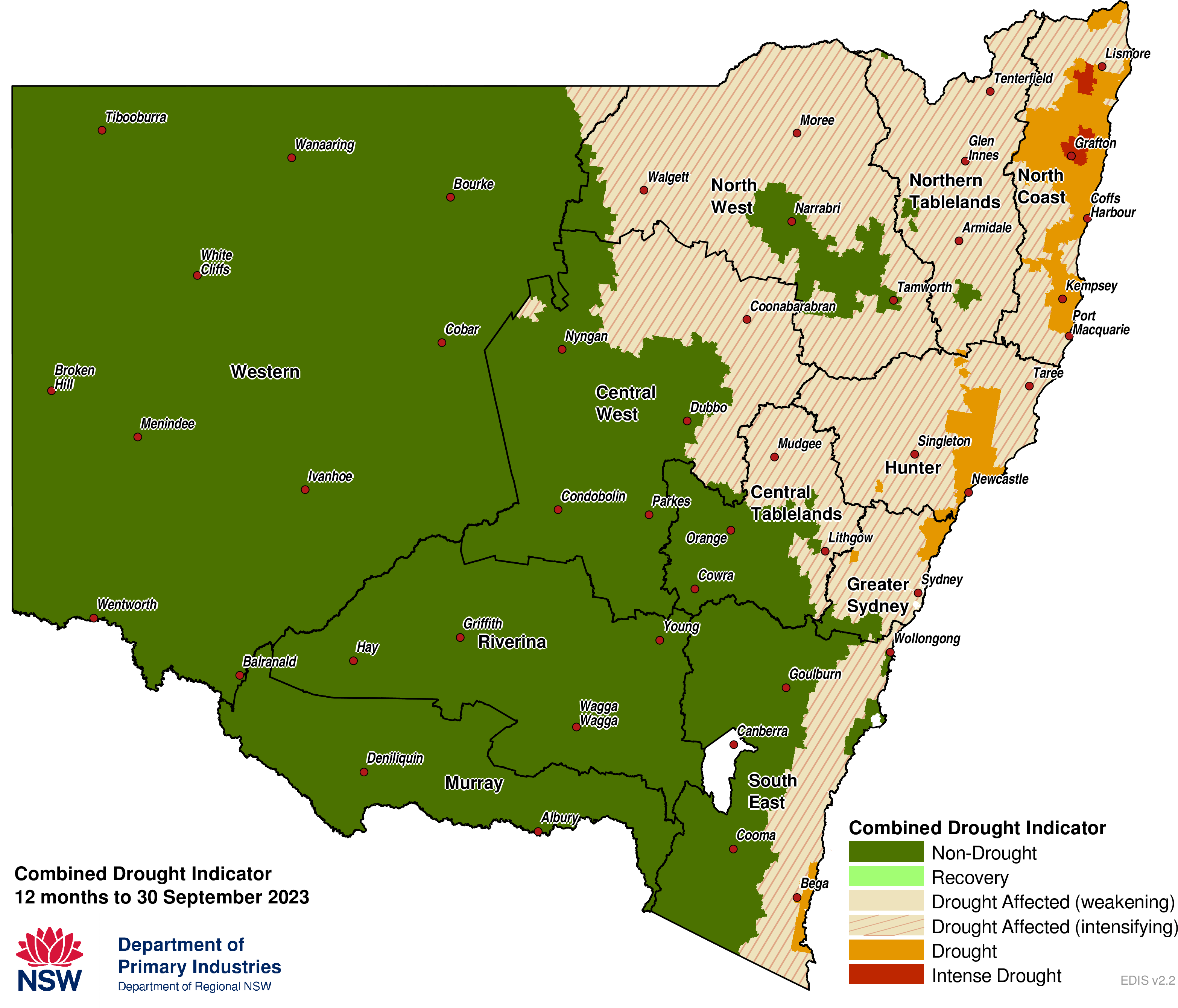
It is important to recognise the CDI provides an aggregated view of NSW, and that on-ground conditions can be different to those displayed in the maps. They provide an ‘on average’ view of a particular region only.
Rainfall
Rainfall was variable during September (Figure 2a). Most areas in eastern NSW received between 5 to 50mm of rainfall. The highest monthly rainfall totals (above 50mm) were recorded in the southern tableland regions of NSW. Western NSW generally received less than 5mm of rainfall.
For the calendar year to date, eastern NSW has received between 200 to 600mm of rainfall. Areas around the southern highlands, and isolated areas in the North Coast LLS region have received more than 800mm. West of the Great Dividing Range has generally received rainfall between 100mm and 400mm (Figure 2b). Year to date rainfall has been average to very much below average for most of NSW.
The rainfall anomaly data shows the difference between total September monthly rainfall and the long-term average monthly rainfall (1981 – 2010; Figure 2c). There has been a negative rainfall anomaly across NSW during September. This follows several consecutive months of widespread negative rainfall anomalies for NSW.
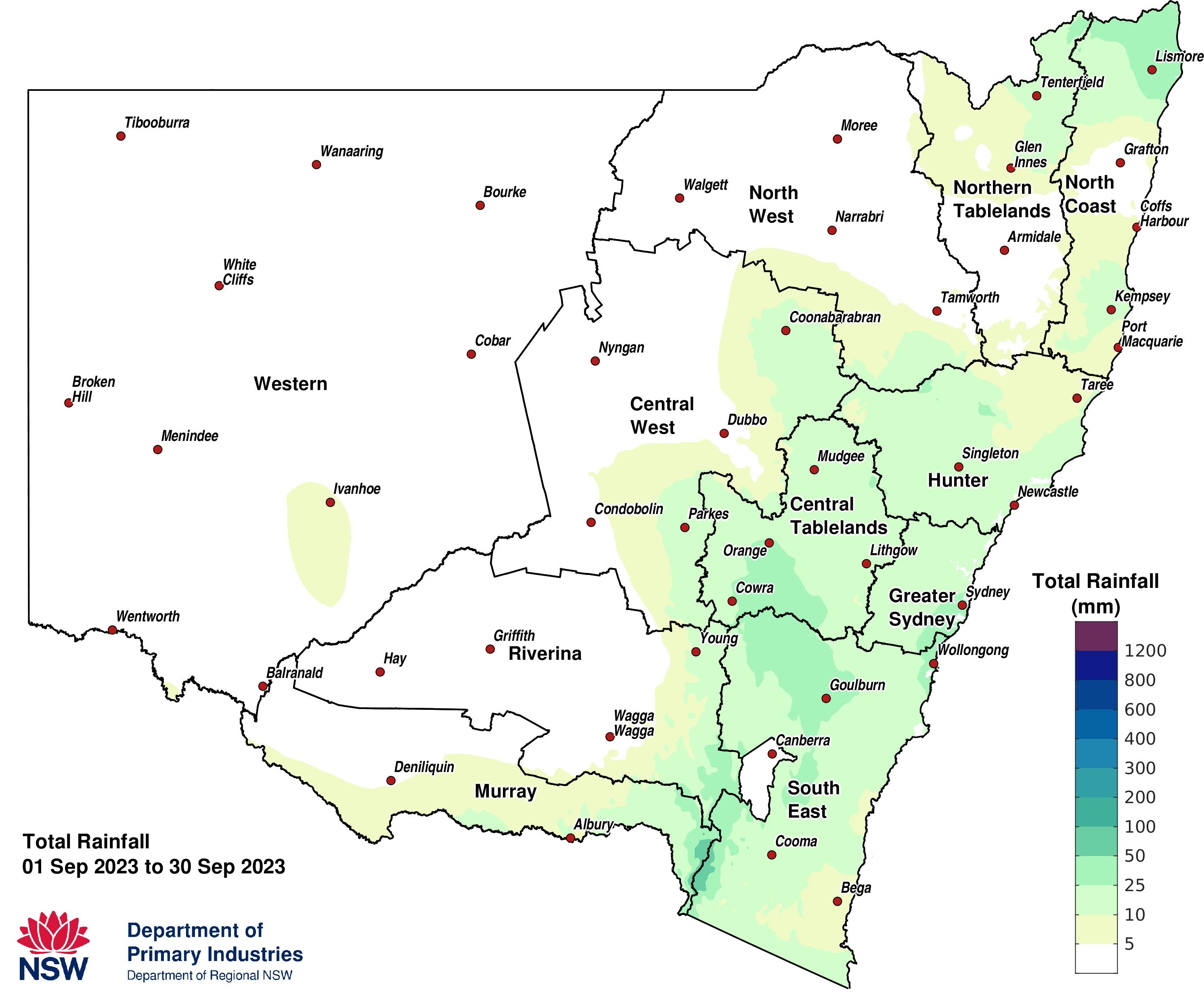
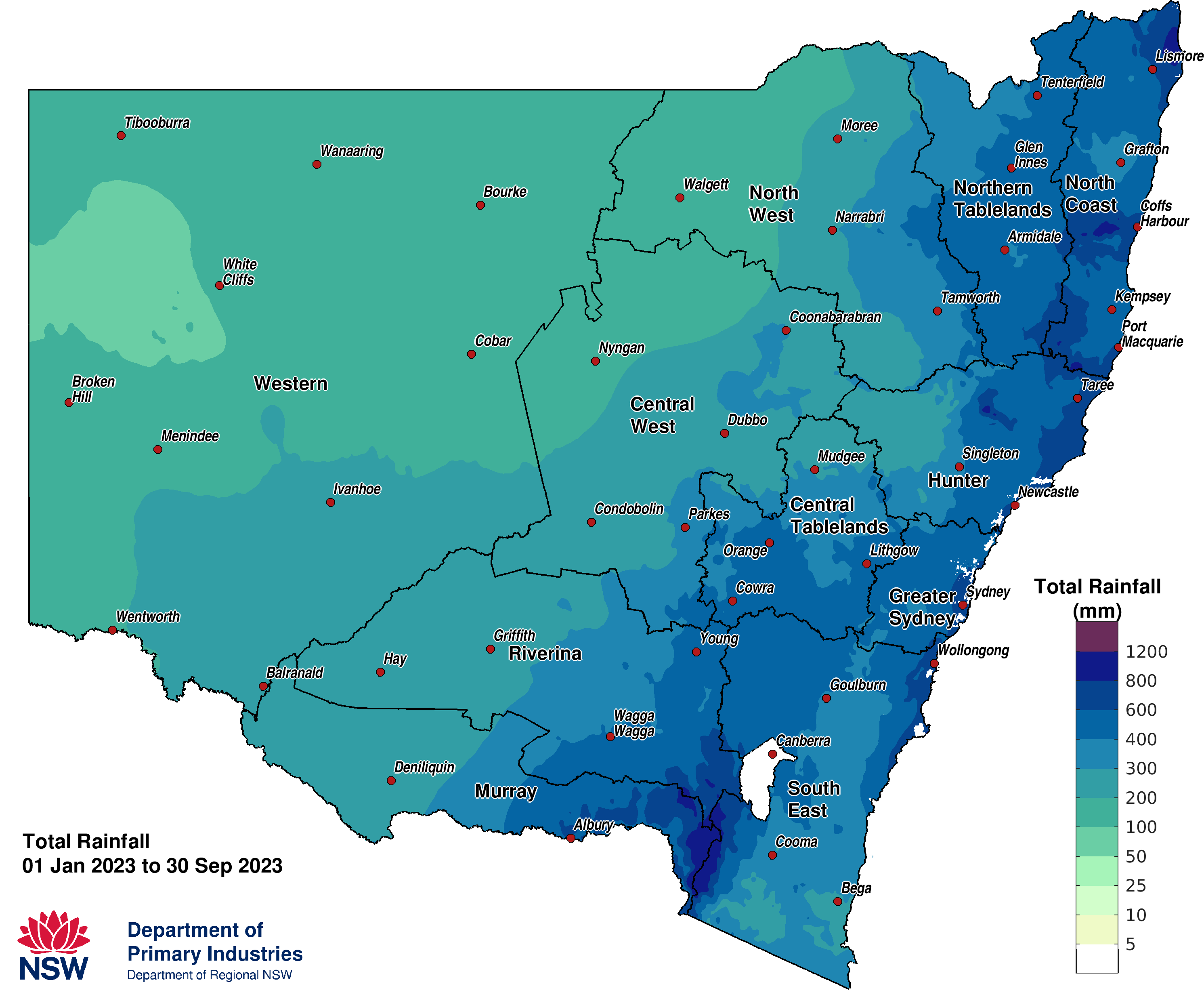
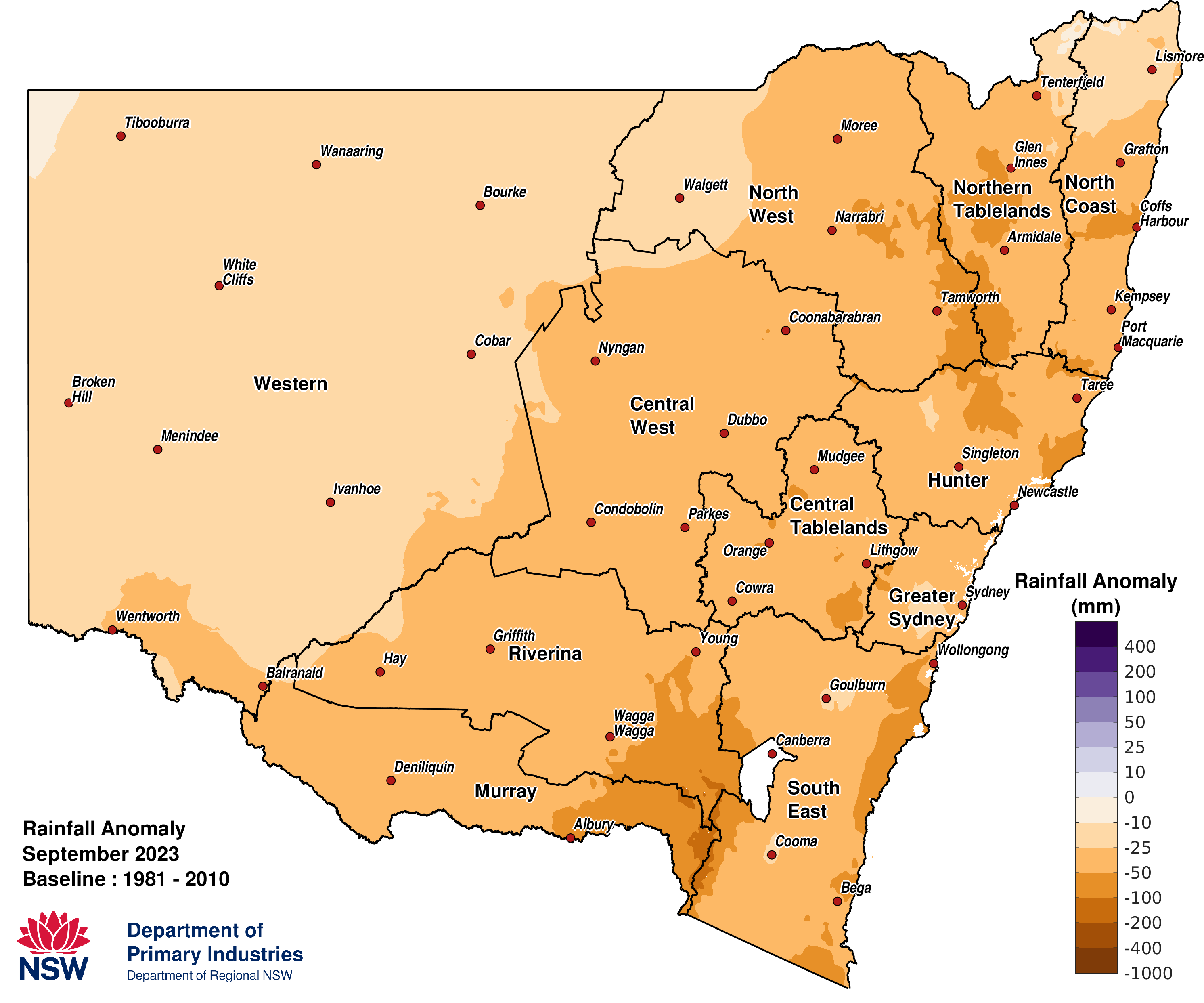
Temperature
In September, the average maximum temperatures ranged from 9°C in the southern alps to above 27°C in the northwest of NSW (Figure 3a). Most of NSW had an average maximum temperature above 18°C during September.
Above average maximum temperatures were experienced across most of NSW in September. Maximum temperatures were generally between 1°C and 5°C above average (Figure 3b). Parts of central NSW recorded maximum temperatures up to 6°C above average.
Minimum temperatures were generally between 3°C and 12°C for most of NSW. The alpine, Hilltops and central tablelands regions ranged between 0°C to 3°C. The warmest temperatures (above 12°C) were along parts of the far north coastal fringe and the far northwest of the state (Figure 3c).
Minimum temperature anomalies were generally between -1 and 1°C for most of NSW during September (Figure 3d). Cooler anomalies of more than 2°C occurred in parts of the central west of NSW. Warmer anomalies of more than 2°C were recorded in parts of the southern alpine region.
Frost events were experienced at higher altitudes across the tablelands, alpine region and extending into the Central West and Riverina. The alpine and southern tableland regions experienced the highest number of frost days during September (Figure 3e).
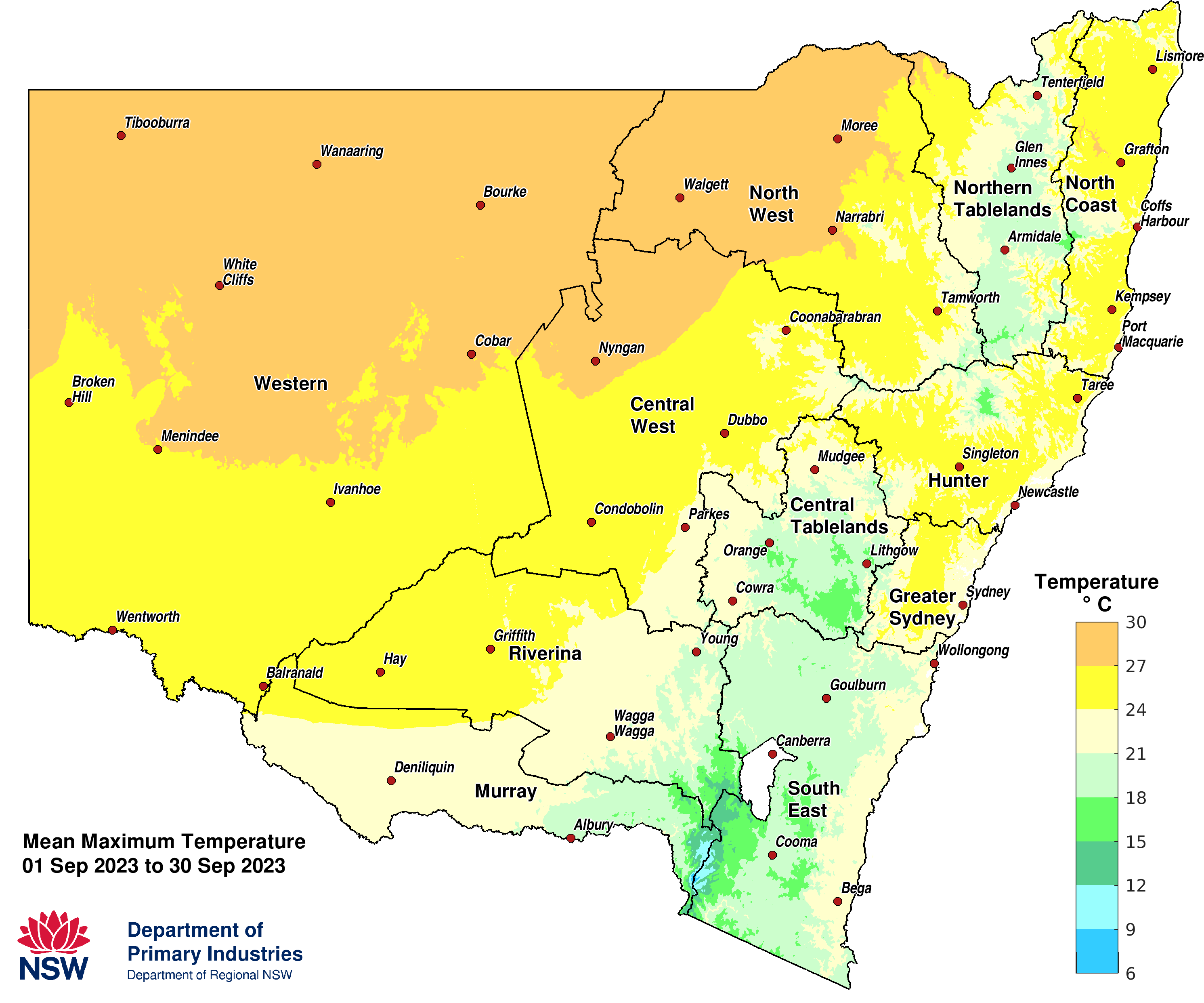
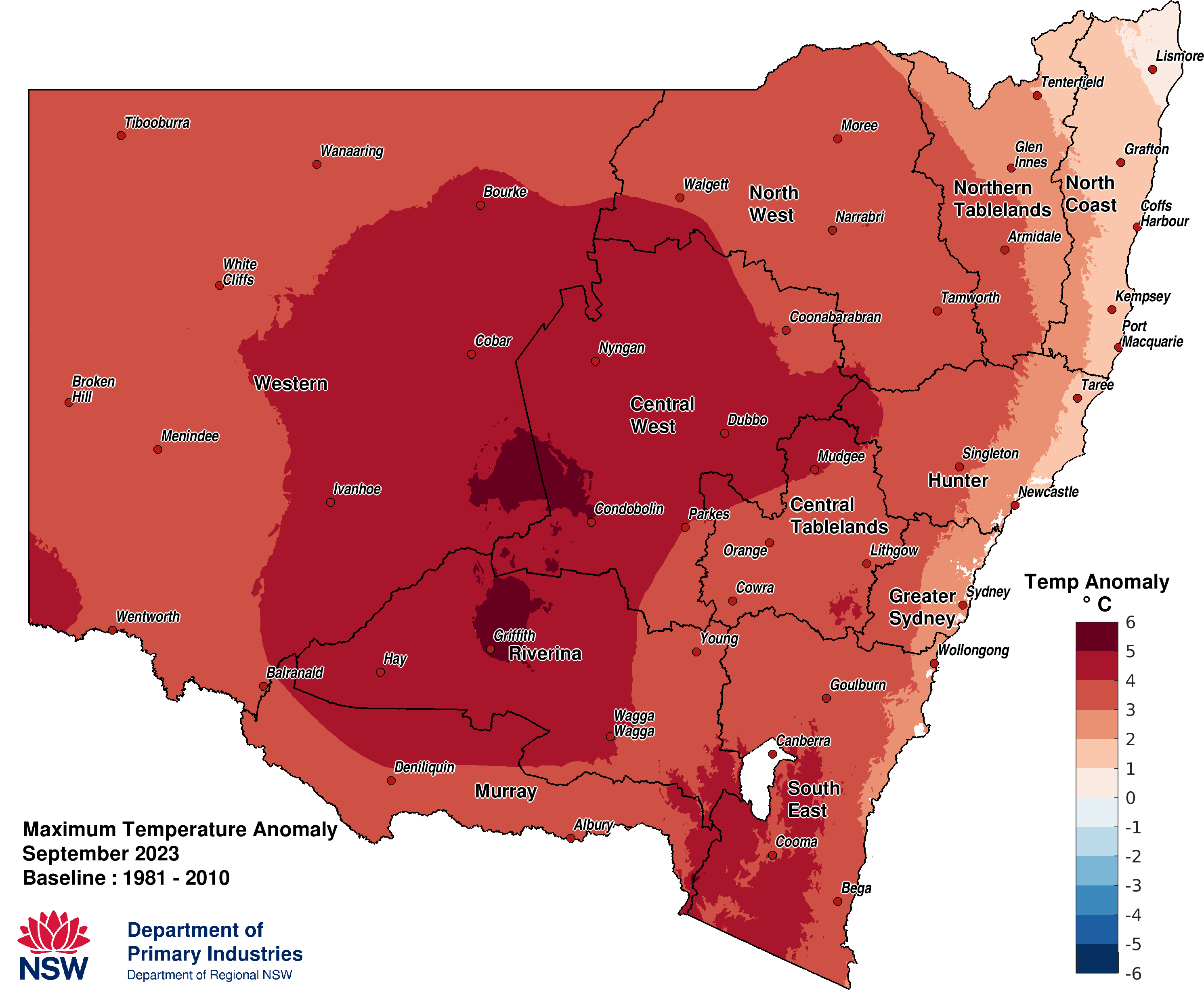
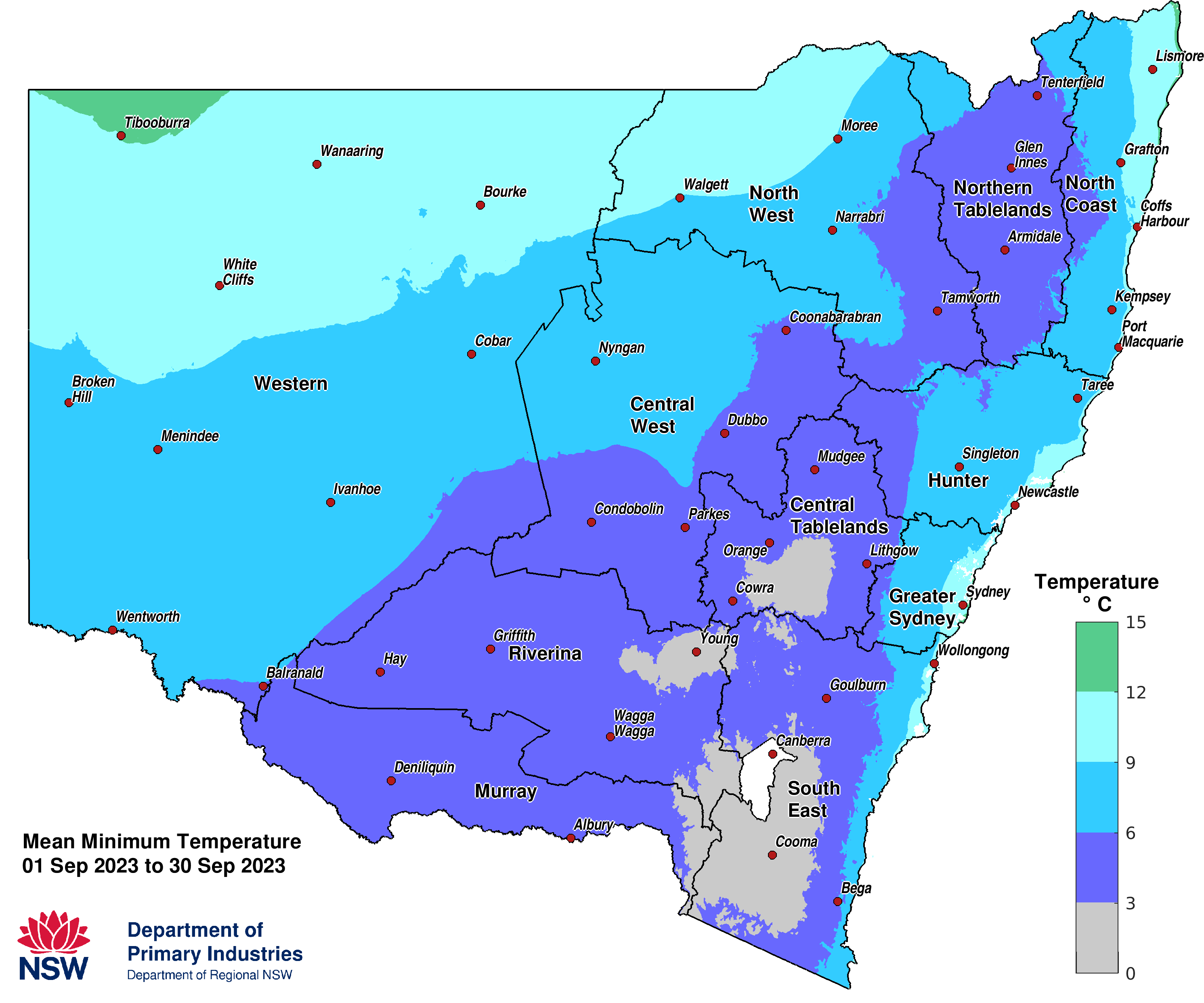
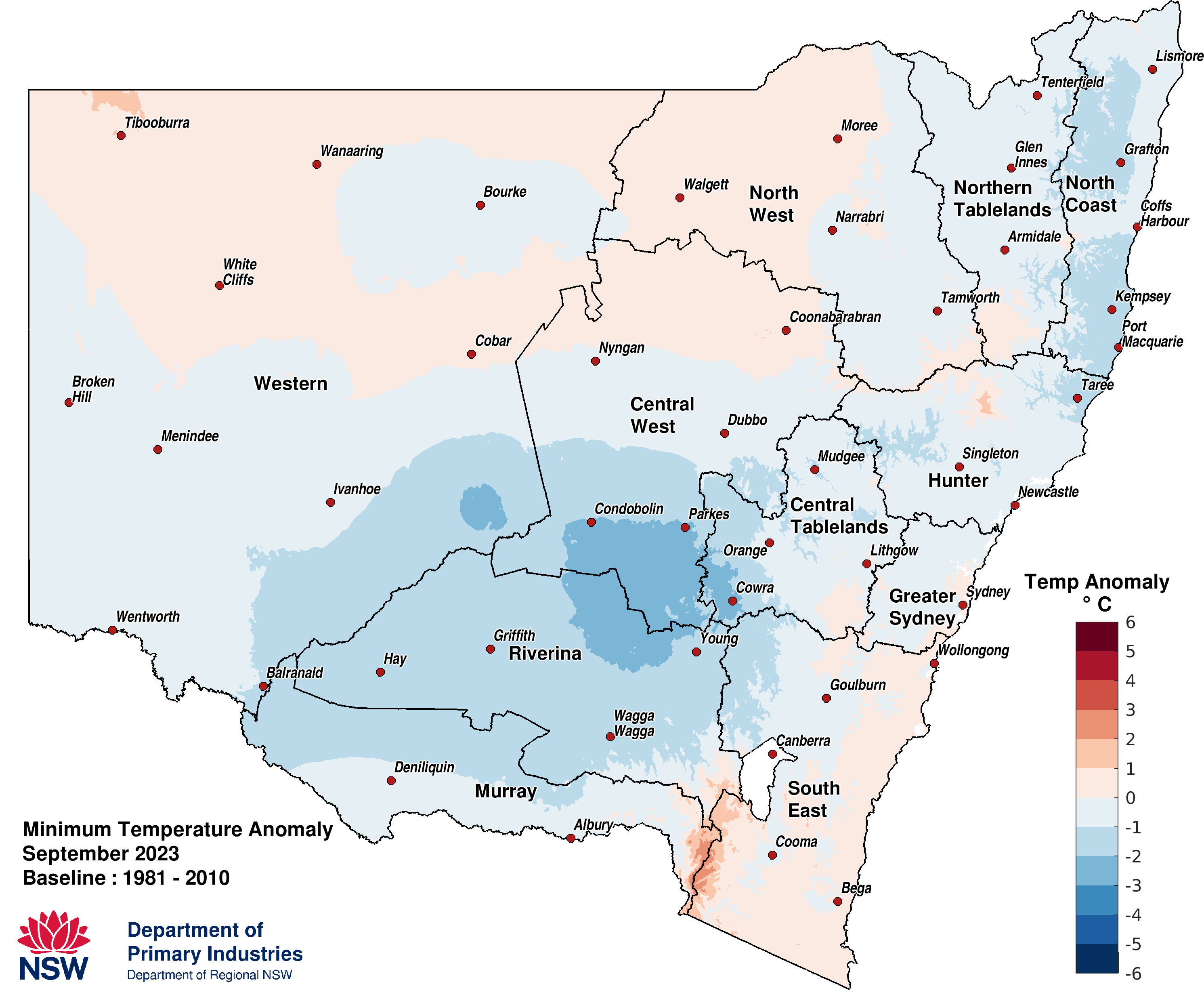
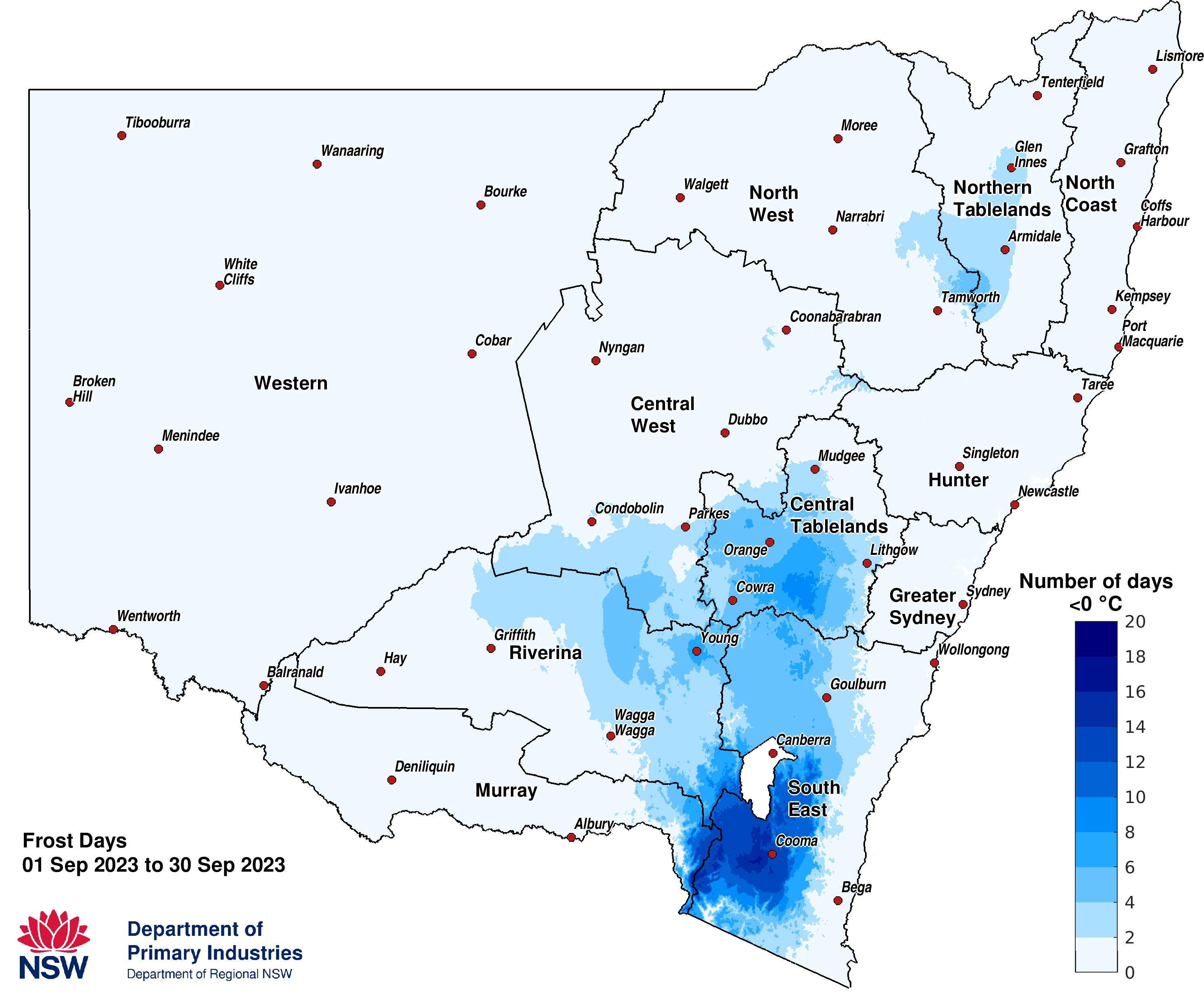
Normalised Difference Vegetation Index (NDVI) Anomaly
The seasonal Normalised Difference Vegetation Index anomaly (NDVI, Figure 4) indicates that plant greenness levels are variable across NSW. Due to data acquisition issues, September data is not included in this update. To the end of August, many areas had above normal plant greenness levels. Areas of below average plant greenness have emerged across NSW. Regions where there were pronounced zones of below normal greenness are the Central West, Hunter, North West, South East, North Coast and Western Local Land Services areas. The data available identifies considerable farm to farm variability in plant condition within the drought areas identified by the NSW CDI. Some of the extremely negative NDVI areas (brown patches) are water bodies.
The monthly NDVI analysis has a closer resemblance to on-ground physical observations than long term drought indices like the CDI which summarise the last 12 months. The low levels of plant greenness, relative to values recorded from a baseline of 1998-2010 indicate low levels of ground cover and standing dry matter available for livestock. The patterns across NSW reported in this Update are from the Landsat satellite. They are consistent with remote sensing data from the National Feedbase Monitor released by Cibo Labs and Meat and Livestock Australia which estimate these metrics directly using different satellite data (Sentinel) and comparative baseline period (from 2018).
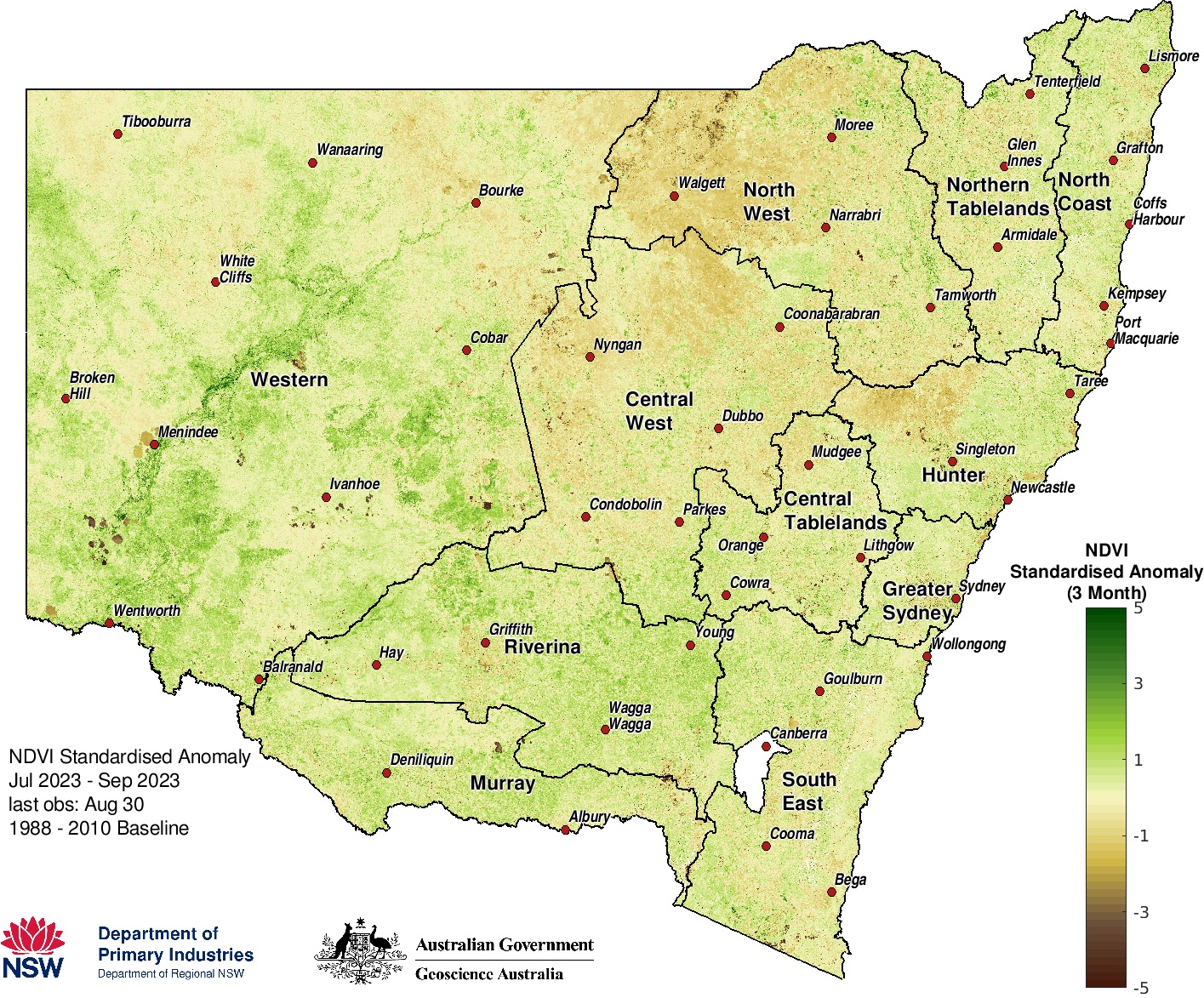
Tools for drought feeding livestock
NSW Department of Primary Industries’ Drought & Supp Feed Calculator app has been re-released to support NSW livestock producers with their decision making as seasonal conditions change.
The Drought & Supp Feed Calculator simplifies decision making for livestock producers by enabling users to assess pastures and work out feed requirement and if supplementary feeding is needed, compare different supplements and ration mixes, and calculate the costs of different feeding options.
Search for Drought & Supp Feed Calculator and download the application from your app store.
NSW Farm Dam Survey
The NSW Farm Dam Survey has not been updated this month because of technical data acquisition issues .
NSW DPI Farm Tracker Reports
NSW DPI Farm Tracker Application reports are completed by users across NSW. On the ground reports submitted on the NSW DPI Farm Tracker application (Figure 5) show producers in several regions are reporting they are managing mild to very severe drought conditions in September.
![]()
Tools for farmers to monitor and report seasonal conditions
The Farm Tracker application is freely available and can be used to help monitor seasonal conditions on your property. Completing a report allows a user to create a geotagged photo diary, monitor dam levels, or record changes at an individual paddock level.
This information provides a detailed and visual record of a farm over time that can be invaluable for budgeting, planning and decision making. The data collected for each farm is not available for other people to see or search.
Reports are also used by NSW DPI as a highly valuable information source to ground truth products from the DPI Seasonal Conditions Monitoring Program. Farmers data remains anonymous in this use.
Search for NSWDPI Farm Tracker and download the application from your app store.
Soil Water Index
The Soil Water Index (SWI, Figure 6) shows conditions are variable across NSW. Parts of the North Coast, Hunter, Greater Sydney and South East LLS regions are showing Extremely Low soil water values. The area in the Below Average category has expanded since the August Update. Substantial rainfall in many areas is needed to trigger an improvement in the SWI.
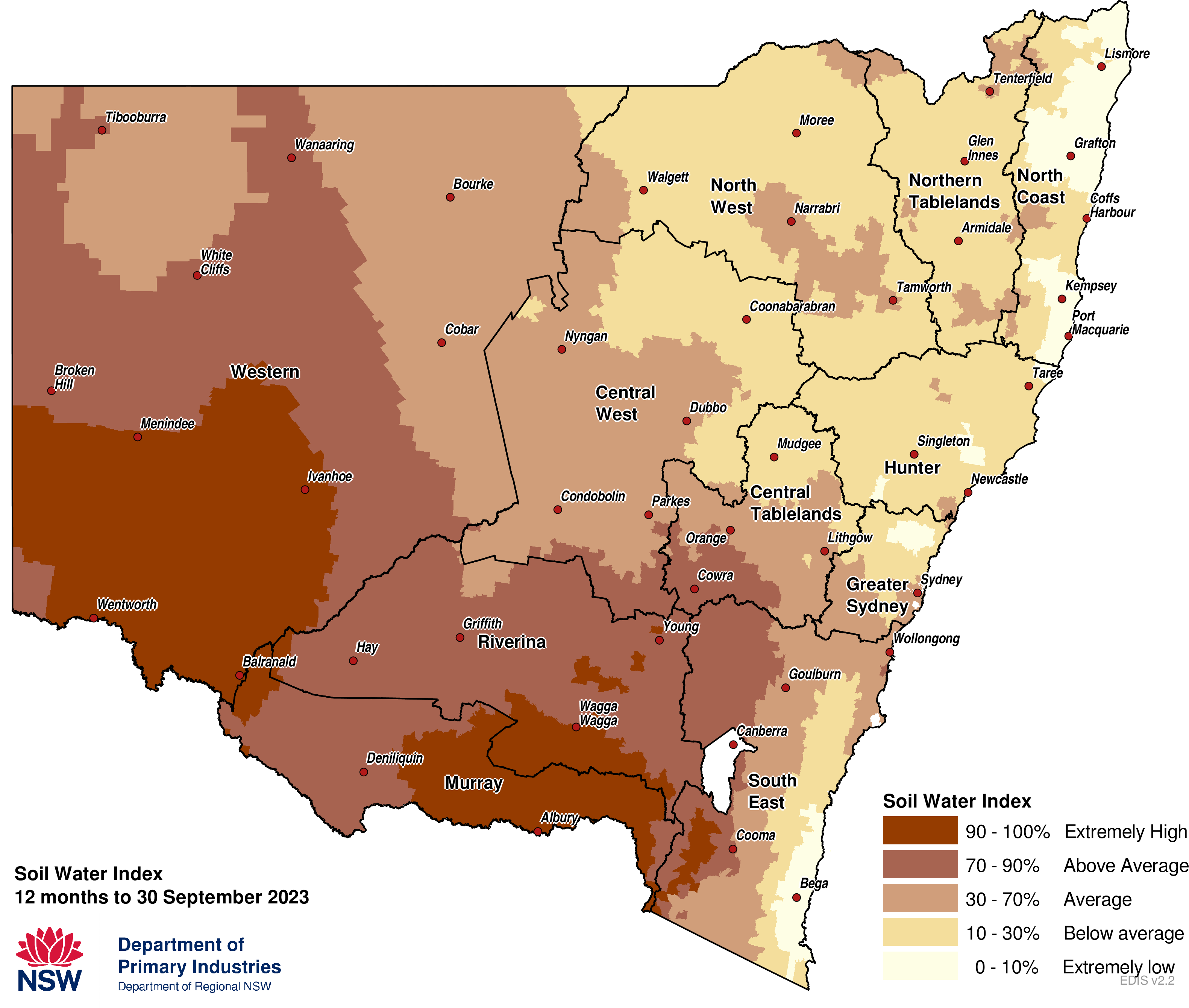
Plant Growth Index
The Plant Growth Index (PGI, Figure 7) shows that most of NSW remains in the Average to Extremely High PGI category. The area in the Below Average category on the North Coast, Northern Tablelands, South East and Hunter has expanded since the August Update. Parts of the North Coast LLS region are in the Extremely Low category.
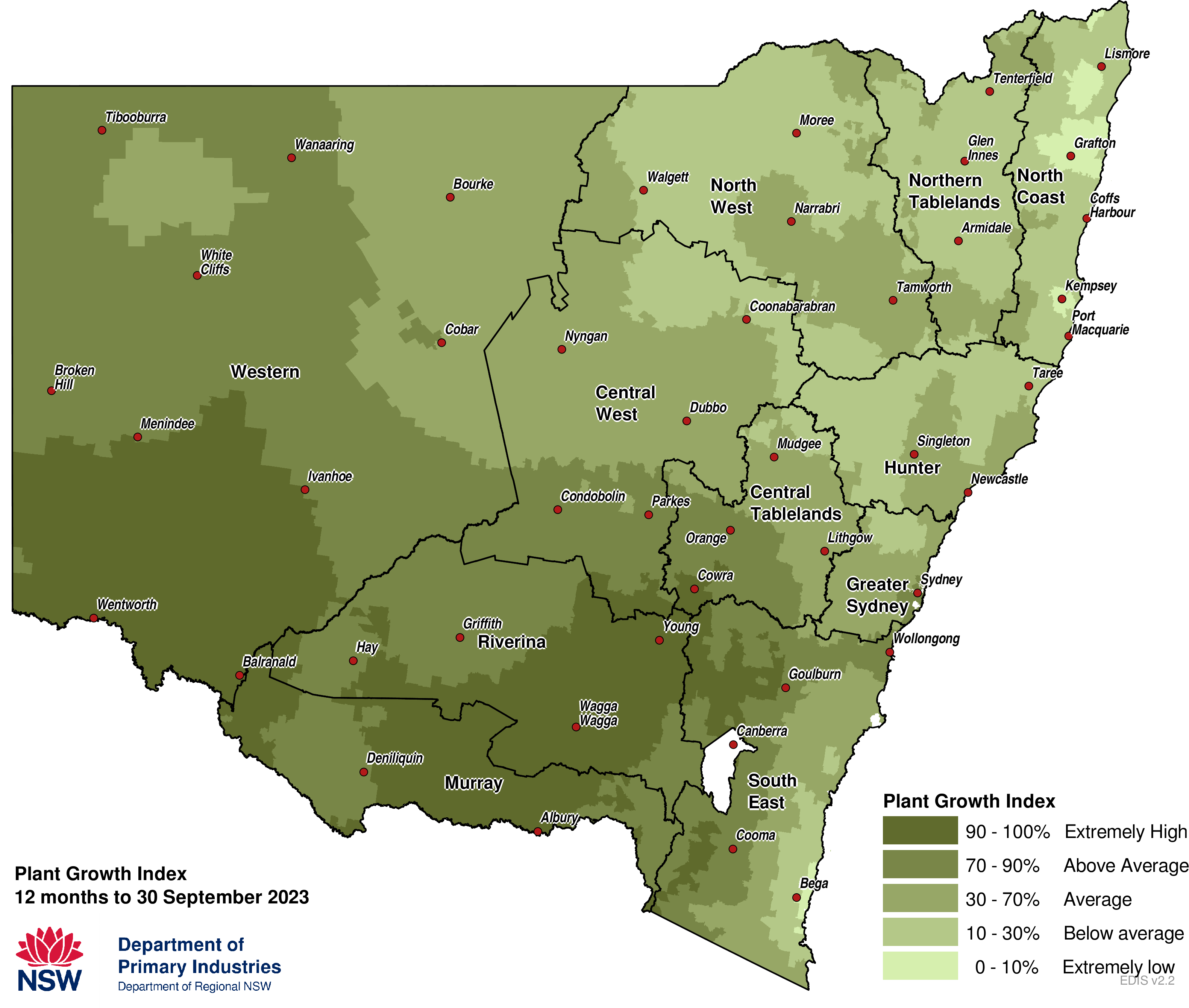
Rainfall Index
The Rainfall Index (RI, Figure 8) shows that most of south west and central NSW remains in the Average to Extremely High category. The area in the Below Average to Extremely Low categories has expanded since the August Update. Most of the North Coast LLS region is in the Extremely Low category, as are part of Northern Tablelands, North West, Hunter, Greater Sydney and South East LLS regions.
Overall, on ground reports confirm the continued decline in the individual indices, with producers managing feed deficits and declines in crop yields due to rainfall deficits and low stored soil water in parts of NSW.
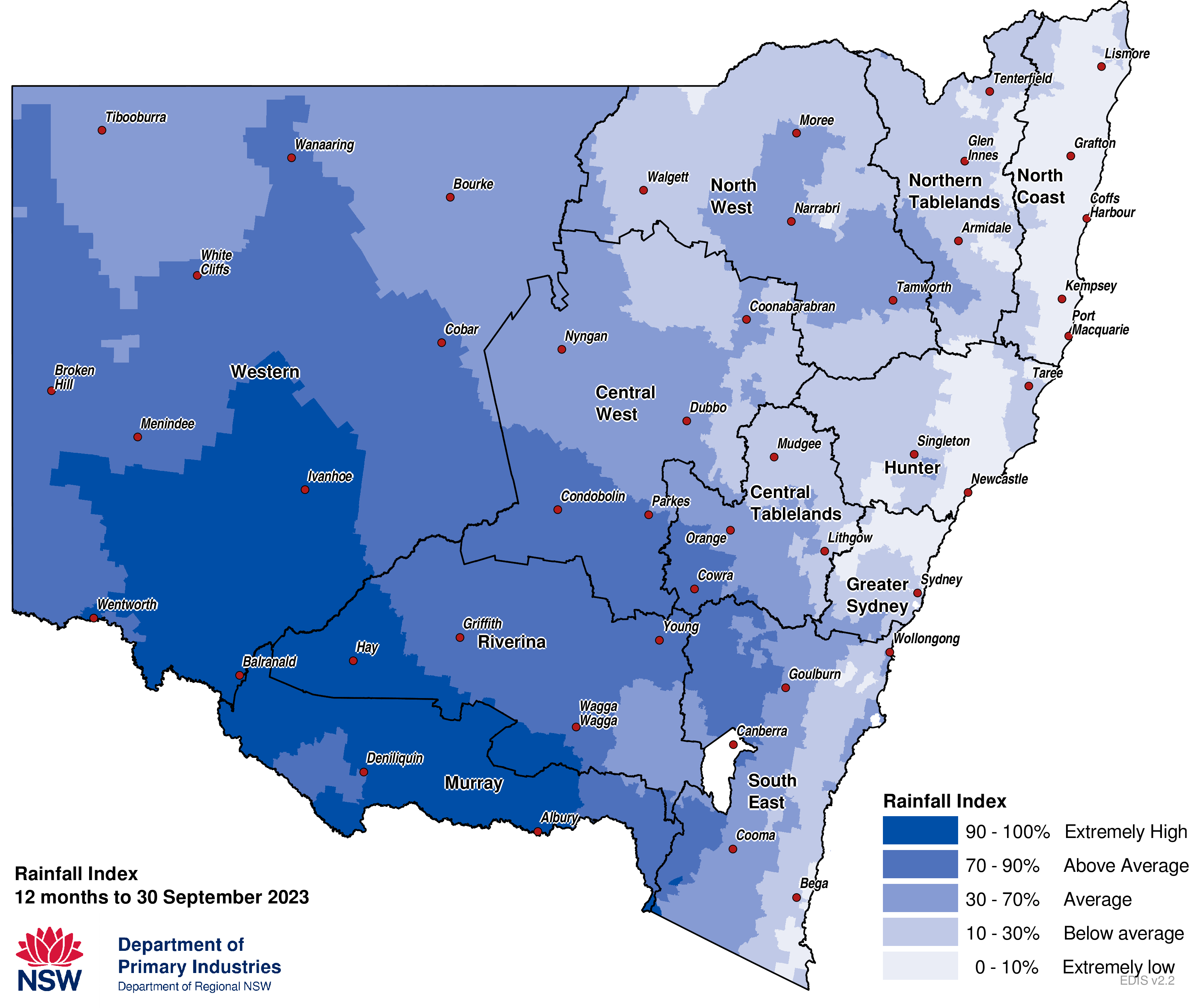
Drought Direction Index
The Drought Direction Index (DDI, Figure 9) tracks the 150-day trend of daily rainfall totals. Western NSW is generally showing a neutral to weak drying trend due to below average rainfall over the past few months. Large areas of eastern NSW are showing a strong drying trend. A small area in the far west is showing a weak wetting trend.
Areas in the Weak and Strong Drying Trend category have experienced a drier August and September compared to previous months. This trend, combined with the decline in the individual drought indicators reflects the deterioration of conditions and the onset of a major drought in these regions.
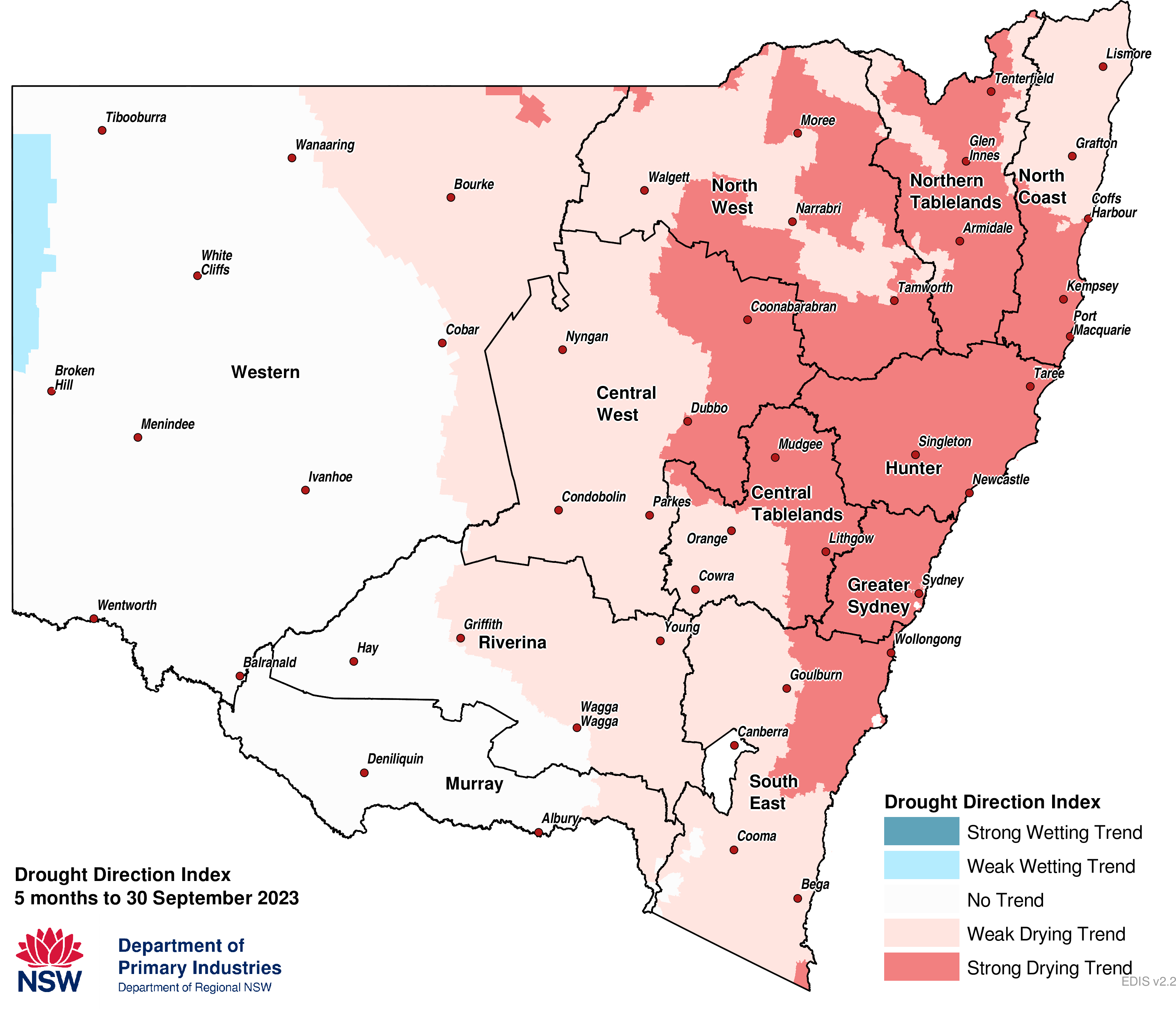
Changes in the individual drought indicators may have occurred since this update was released. For the most current information, please visit DroughtHub.
NSW outlook - November to January
(issued 5 October 2023)
Variable rainfall forecast for NSW
- The seasonal rainfall outlook indicates that there is a near average chance (between 40% to 60%) of median rainfall for most of NSW during the November to January period (Figure 10). There is an above 60% chance of above average rainfall for parts of central NSW and the northwest of the state.
Warm to hot conditions forecast for NSW
- The maximum temperature outlook indicates a more than 80% chance of exceeding median daytime temperatures across NSW during the October to December period (Figure 11).
Warmer nights across NSW
- There is an above 80% chance of warmer than median overnight temperatures across most of eastern, central and southern NSW during the October to December period (Figure 12).
- Across western NSW there is a 55% to above 70% chance of above median overnight temperatures.
Prospect of unstable weather
- Although the forecast is for near average rainfall and warmer temperatures for the three month outlook, other climate drivers like the Southern Annular Mode (SAM) and warm local sea surface temperatures bring the prospect of unstable week to week weather during the forecast period.
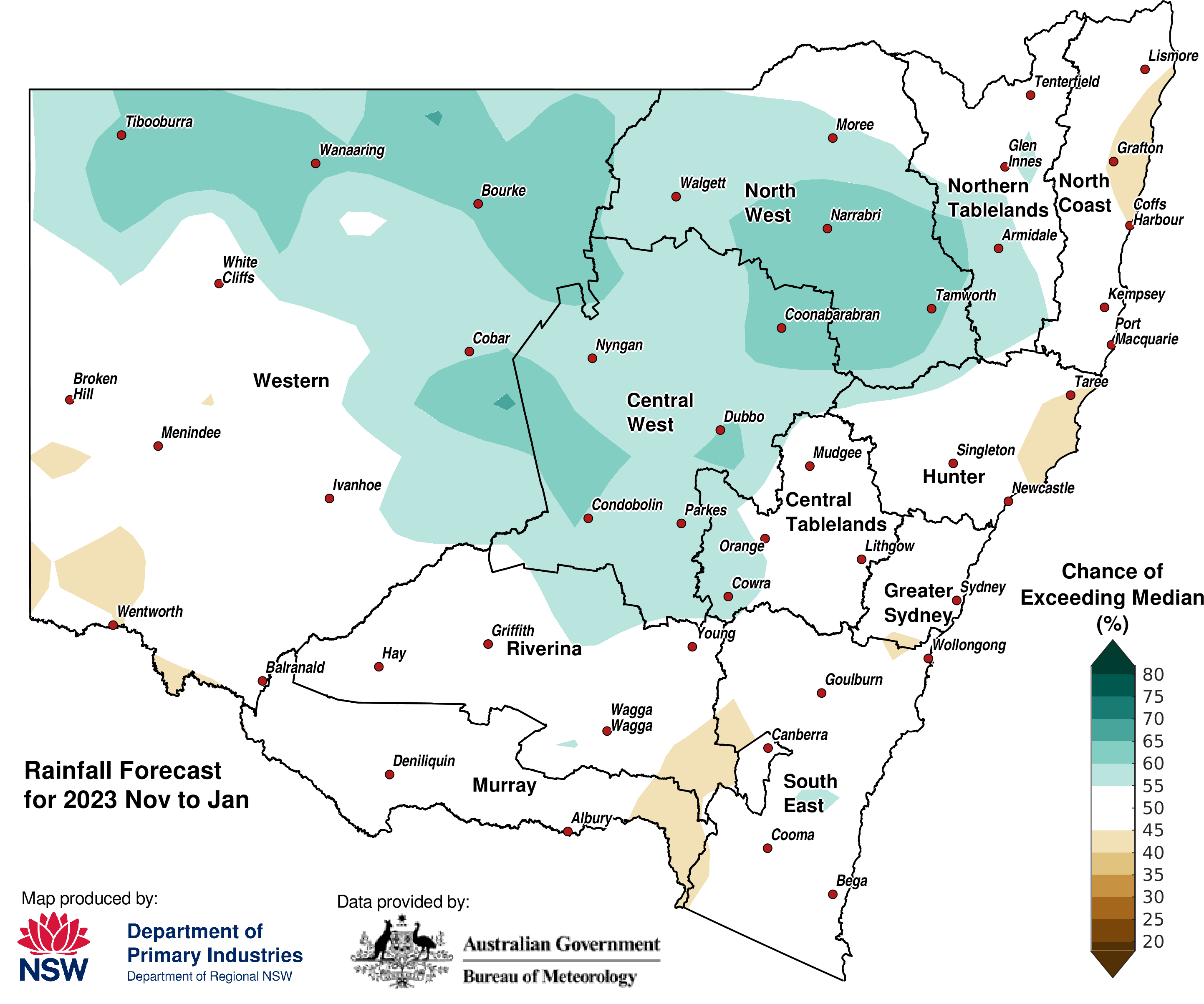
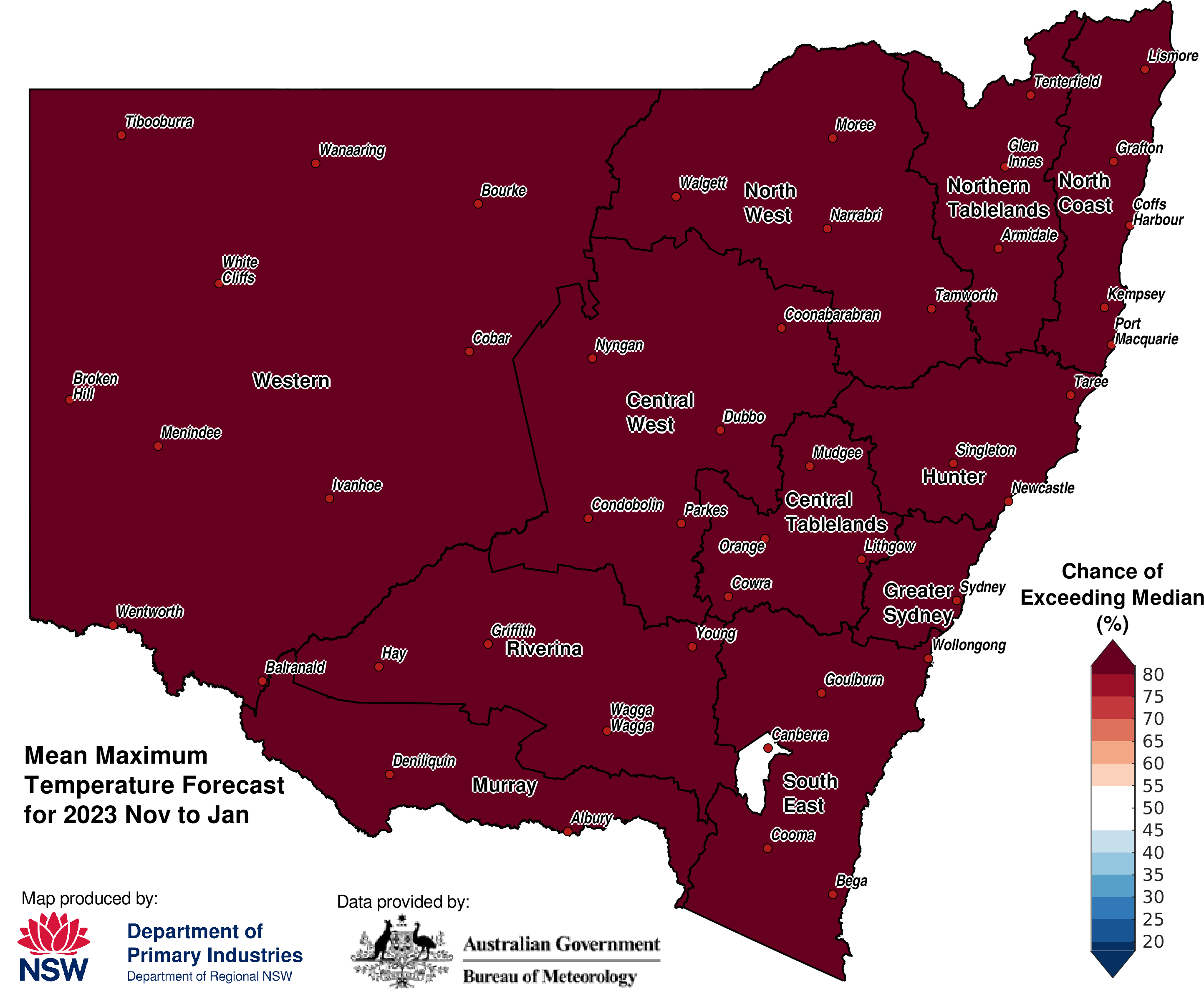
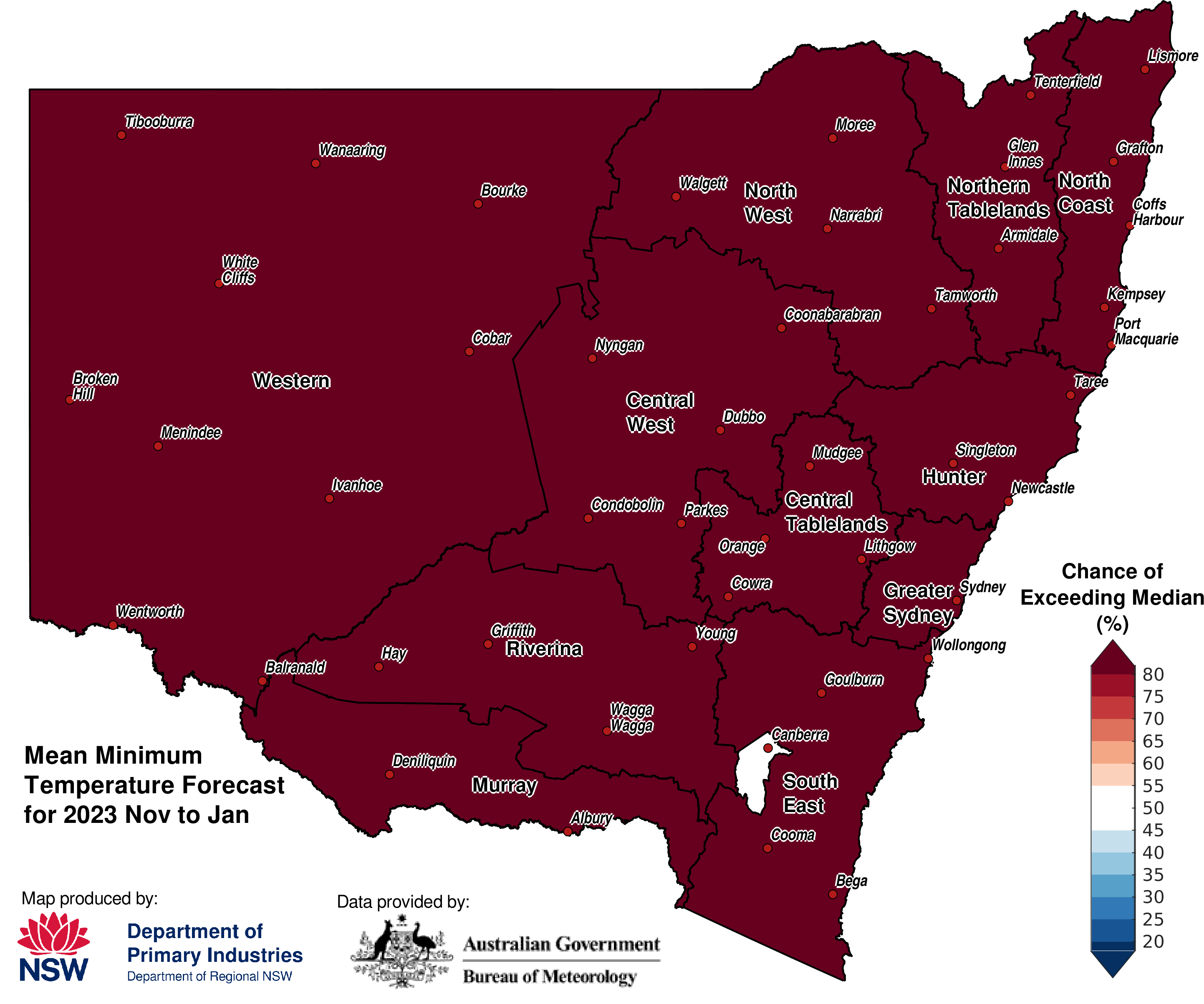
Official national outlook
The official national outlook was released by the Bureau of Meteorology on 5 October 2023. The rainfall outlook for November to January shows that there is likely (60 to 80%) to be below median rainfall for most of western, northern and southern Australia. Parts of NSW are likely (60% to 80% chance) of above median rainfall.
Maximum temperatures for October to December have a very likely chance (greater than 80%) of being warmer than average for most of Australia. Minimum temperatures for the October to December period have a likely to very likely (60% to 80%) chance of being warmer than average for most of Australia.
Forecast accuracy at this time of year has generally been moderate to high for most of Australia. The Bureau issues a new 3-month seasonal update weekly, each Thursday afternoon.
Global climate drivers
El Niño–Southern Oscillation (ENSO)
The Bureau of Meteorology’s El Niño-Southern Oscillation (ENSO) Outlook was released on 26 September 2023. The ENSO Outlook status is at El Niño.
Sea surface temperatures (SSTs) in the tropical Pacific Ocean continue to exceed El Niño thresholds. The Southern Oscillation Index (SOI) is negative. Models indicate that the El Niño is likely to persist until at least the end of February.
Southern Oscillation Index
The 30-day Southern Oscillation Index (SOI; Figure 13) for the 30 days ending 24 September was -16.0. The 90-day SOI value was -10.2. Sustained negative values of the SOI below −7 typically indicate El Niño while sustained positive values above +7 typically indicate La Niña.
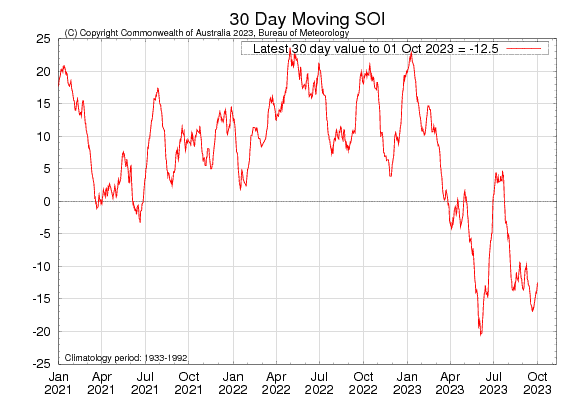
Sea surface temperatures (SST)
Monthly sea surface temperatures (SST) were warmer than average across most of the tropical Pacific Ocean (Figure 14). Warm SST anomalies persist along parts of the Australian coastline. Warm anomalies also remain in the southern Tasman Sea.
The latest values of the three NINO indices in the tropical Pacific for the week ending 24 September were: NINO3 +1.82 °C, NINO3.4 +1.45 °C, NINO4 +1.15 °C (sourced from the Bureau of Meteorology on 4 October 2023).
Persistent NINO3 or NINO3.4 values warmer than +0.8 °C are typical of El Niño, while persistent values cooler than −0.8 °C typically indicate La Niña.
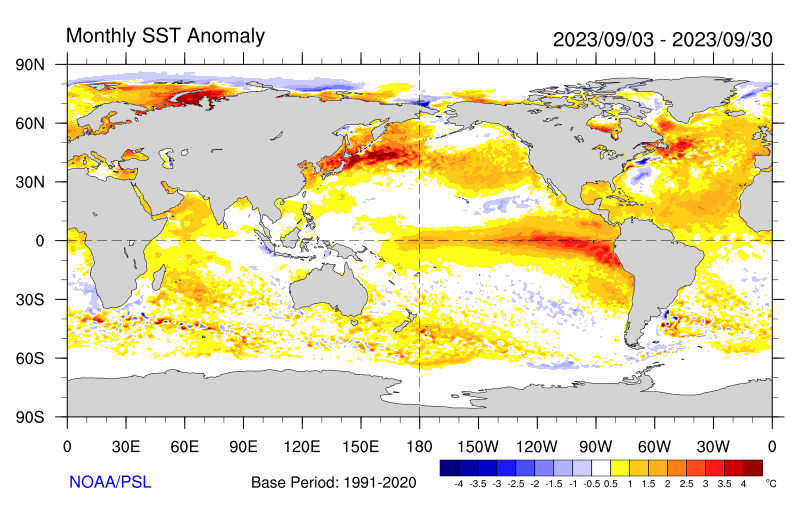
Sub-surface sea temperatures
The four-month sequence of equatorial Pacific sub-surface temperature anomalies (to 25 September 2023) shows warm anomalies across most of the Pacific basin for the top 150m in depth (Figure 15). These warm anomalies reached more than 2oC above average for the eastern Pacific.
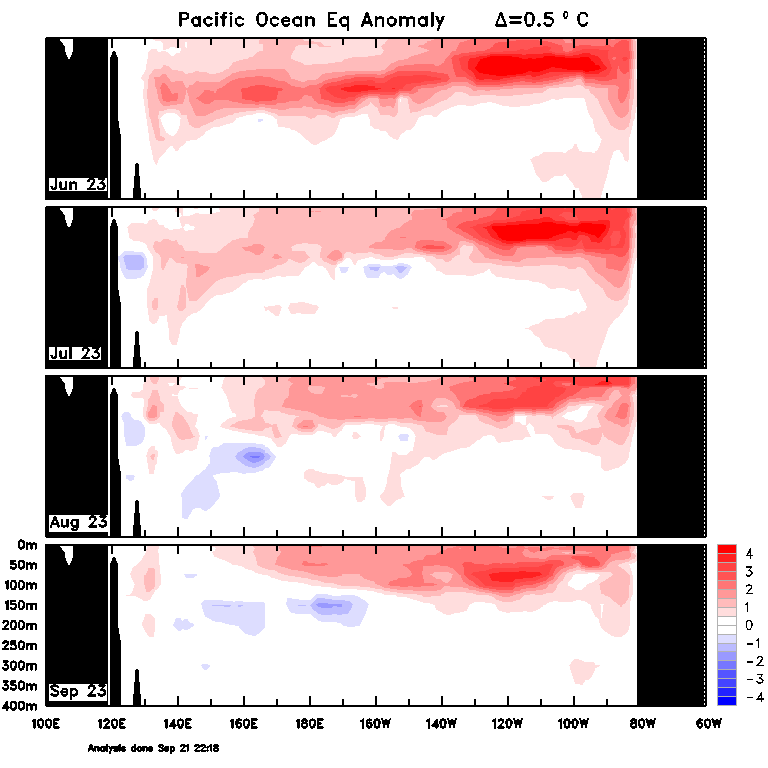
Indian Ocean (IOD)
A positive Indian Ocean Dipole (IOD) is currently underway. The latest weekly value of the Indian Ocean Dipole (IOD) index to 24 September 2023 was +1.45°C. This is the sixth week above the positive IOD threshold (+0.40 °C).
All of the international climate models surveyed by the Bureau of Meteorology suggest a positive IOD event is likely to continue for the remainder of spring. A positive IOD can suppress winter and spring rainfall over much of Australia, including NSW. When a positive IOD and El Niño occur together, their drying effect is typically stronger and more widespread across Australia.
Southern Ocean (Southern Annular Mode – SAM)
The Southern Annular Mode (SAM) index is neutral (as of 26 September). It is expected to remain neutral for the coming fortnight. Near real time SAM data issued on 3 October 2023 (Figure 16) shows a positive SAM, but needs to be assessed by the Bureau of Meteorology before their official update of the state of this climate driver is released.
The Southern Annular Mode (SAM) refers to the north-south shift of rain-bearing westerly winds and weather systems in the Southern Ocean compared to their usual position. This indicator can be quite volatile and generally influences weather conditions on 1 to 3 week timescales. A neutral SAM has little influence on Australian rainfall
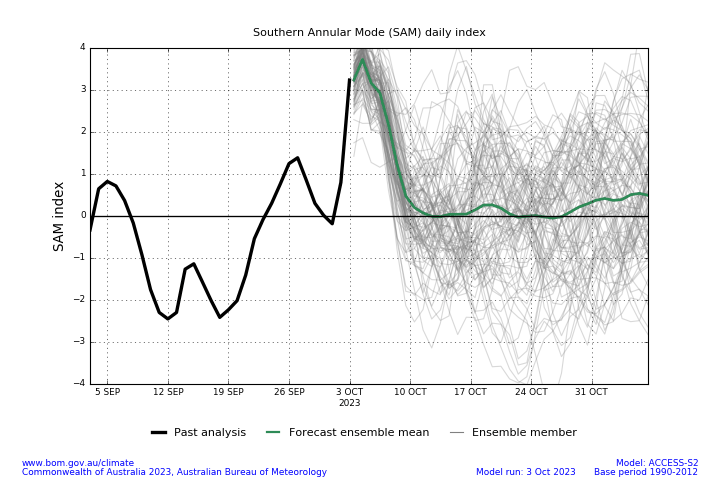
CDI status for the regions
Figure 17 displays the CDI status for each individual Local Land Services (LLS) region to 30 September 2023. The following regional descriptions are based on data available until the end of September 2023.
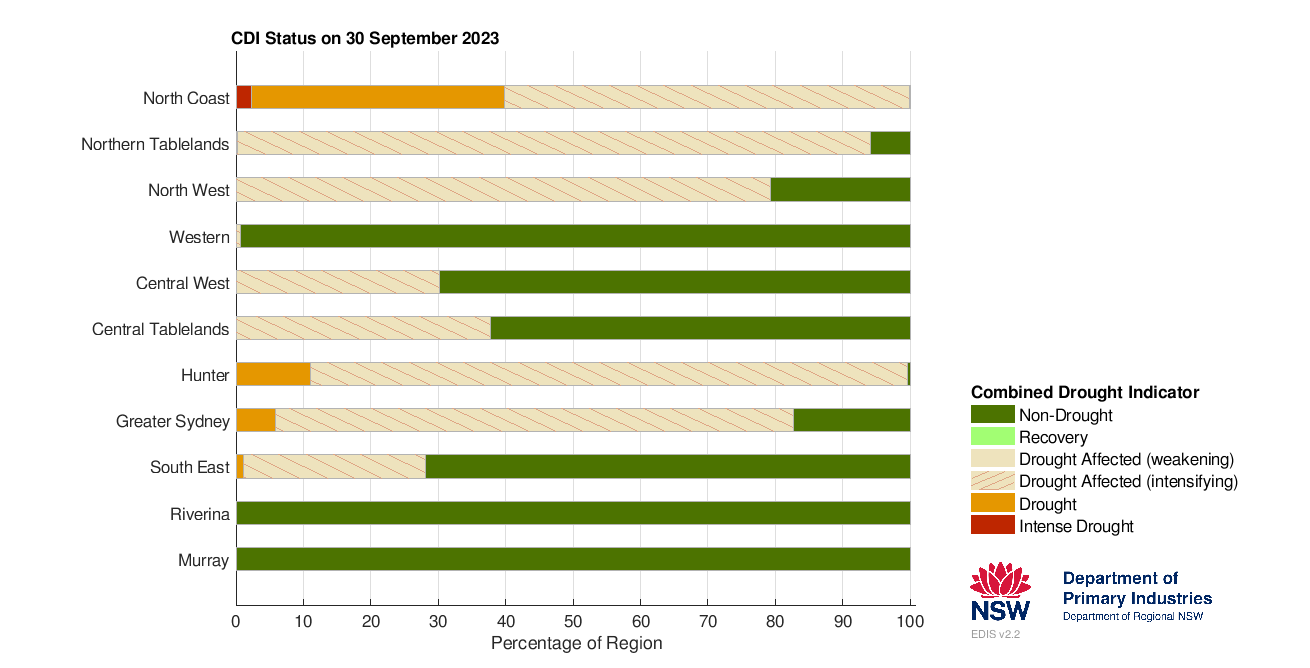
Murray and Riverina regions
Murray and Riverina regions production outlook continues to remain strong. Producers are continuing to monitor their seasonal conditions and forecasts closely in line with their production systems.
The Riverina and Murray Local Land Services (LLS) regions remain in the Non-Drought category at the end of September (CDI, Figure 18).
- September rainfall was very much below average for most of the region.
- Due to data acquisition issues the seasonal NDVI anomaly data is only available to the end of August (Figure 19). At this time, the NDVI shows that most of the Murray and Riverina regions were experiencing normal to higher than normal plant greenness levels. This is a likely a result of vegetation responding to recent widespread rainfall events. Some of the extremely negative NDVI areas (dark brown patches) represent water or fallowed paddocks.
Drought indicators remain stable.
- The Drought History charts (Figure 20) show the individual response of the drought indicators for Hay, Temora, Finley, and Moulamein.
- The indicators remain high at all locations however there has been a decline in the individual drought indicators over the past month. The production outlook remains strong however producers should continue to monitor conditions closely.
- To access a Drought History chart for your Parish, visit the Seasonal Conditions Information Portal.
The Combined Drought Indicator (CDI) is a tool that monitors drought conditions across NSW. The drought categories are based on assessing the response of three drought indicators: soil water, plant growth and rainfall. The indicators track the data over the past 12 months and show how the indices are tracking compared to long-term averages. The information provided in the map is aggregated to a Parish level and provides a regional assessment of conditions. Variability within and between farms is possible and this may not be reflected in the CDI map.
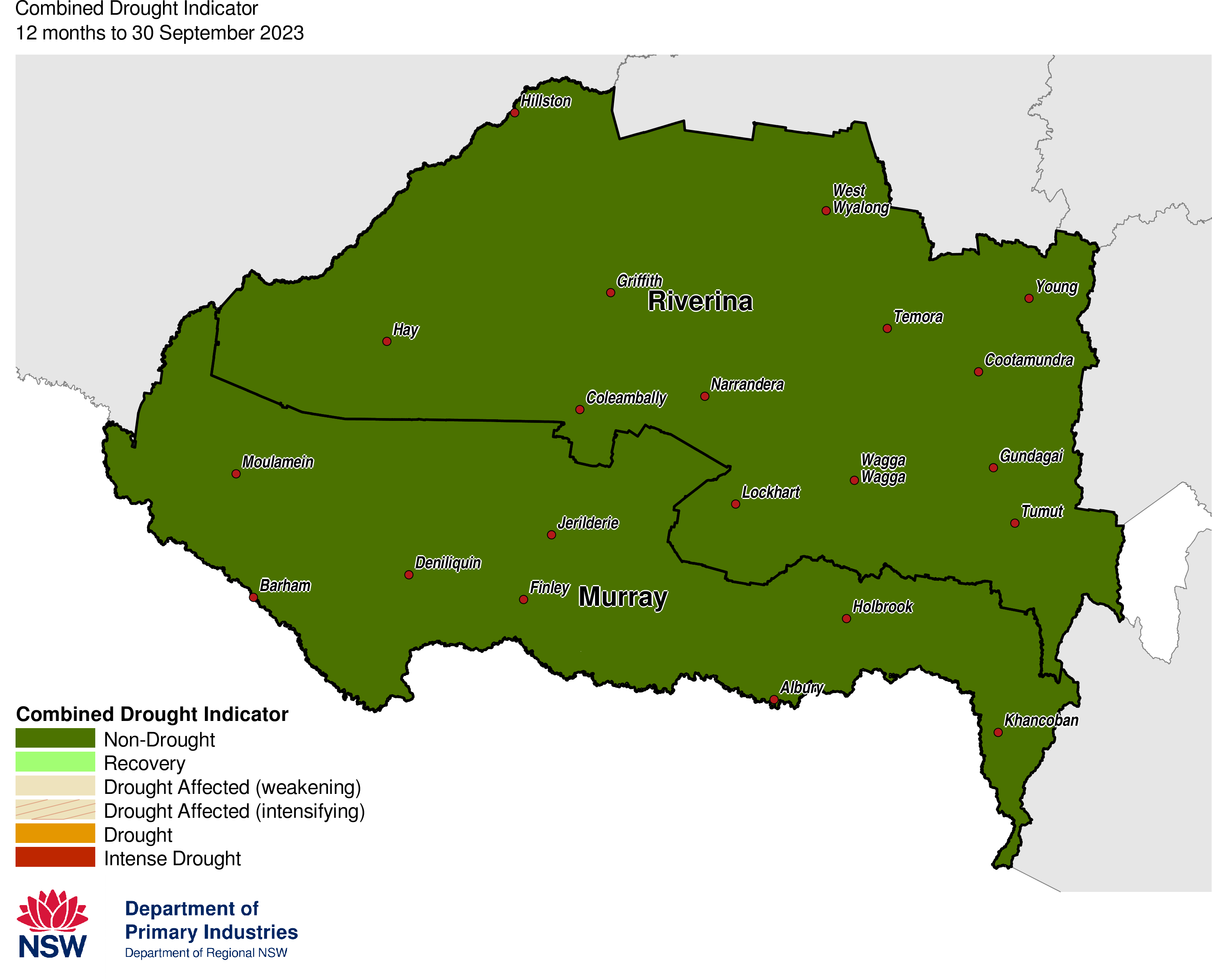
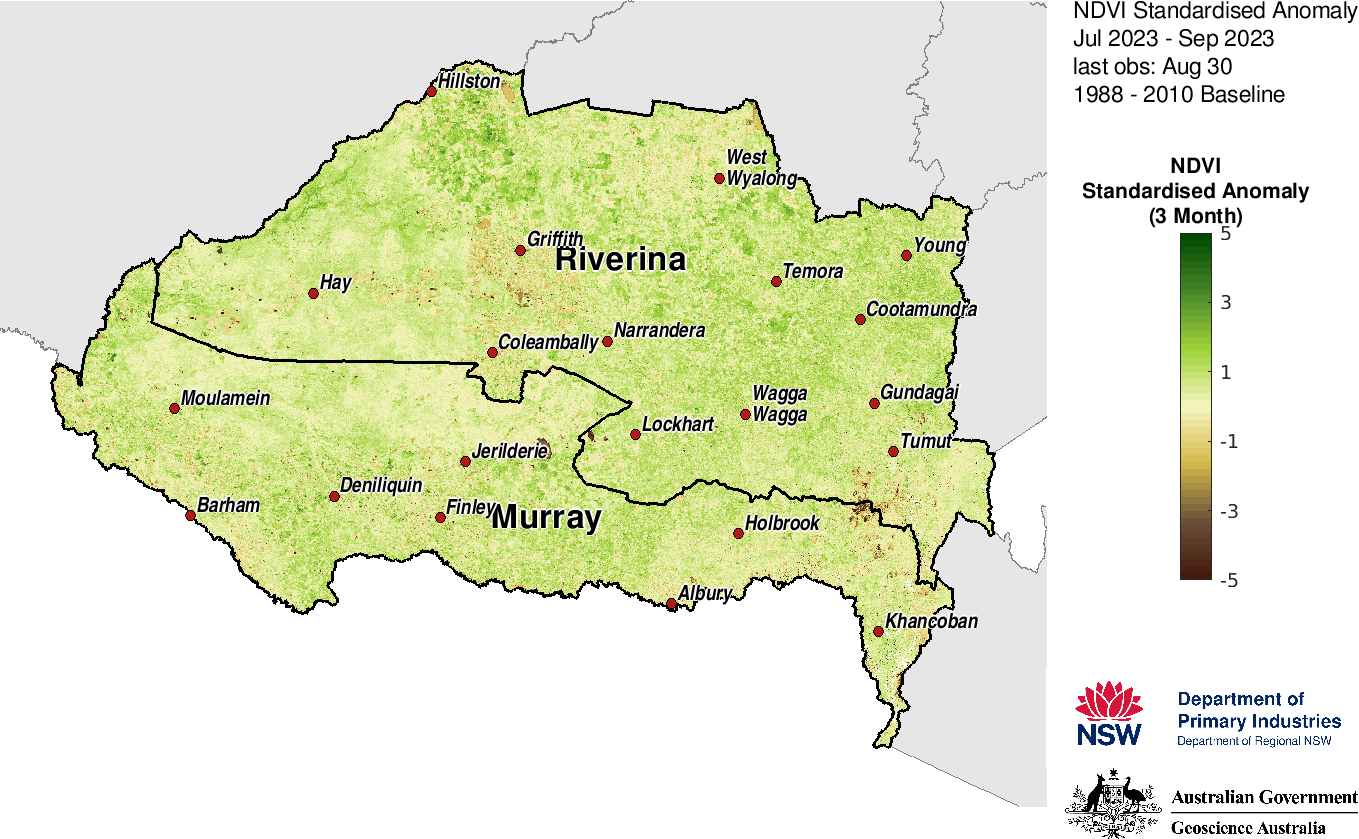
![]()
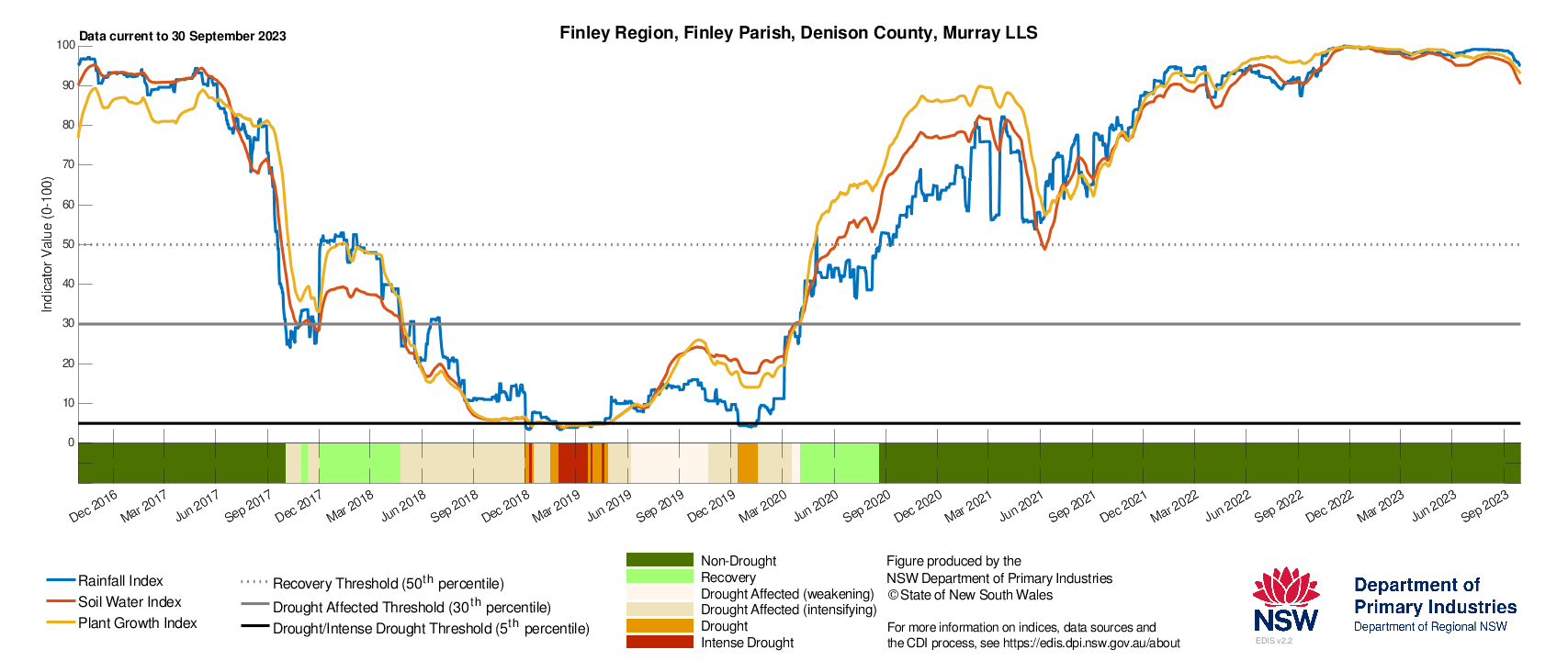
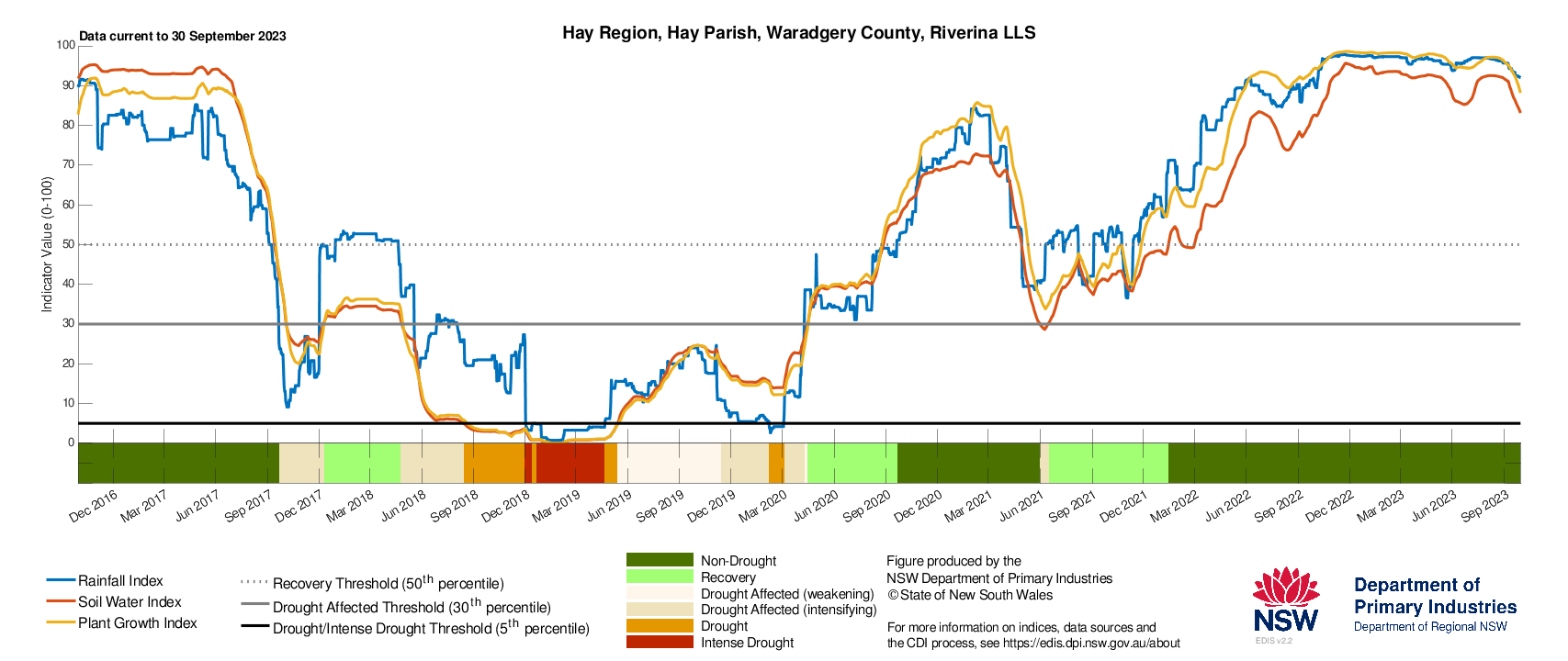
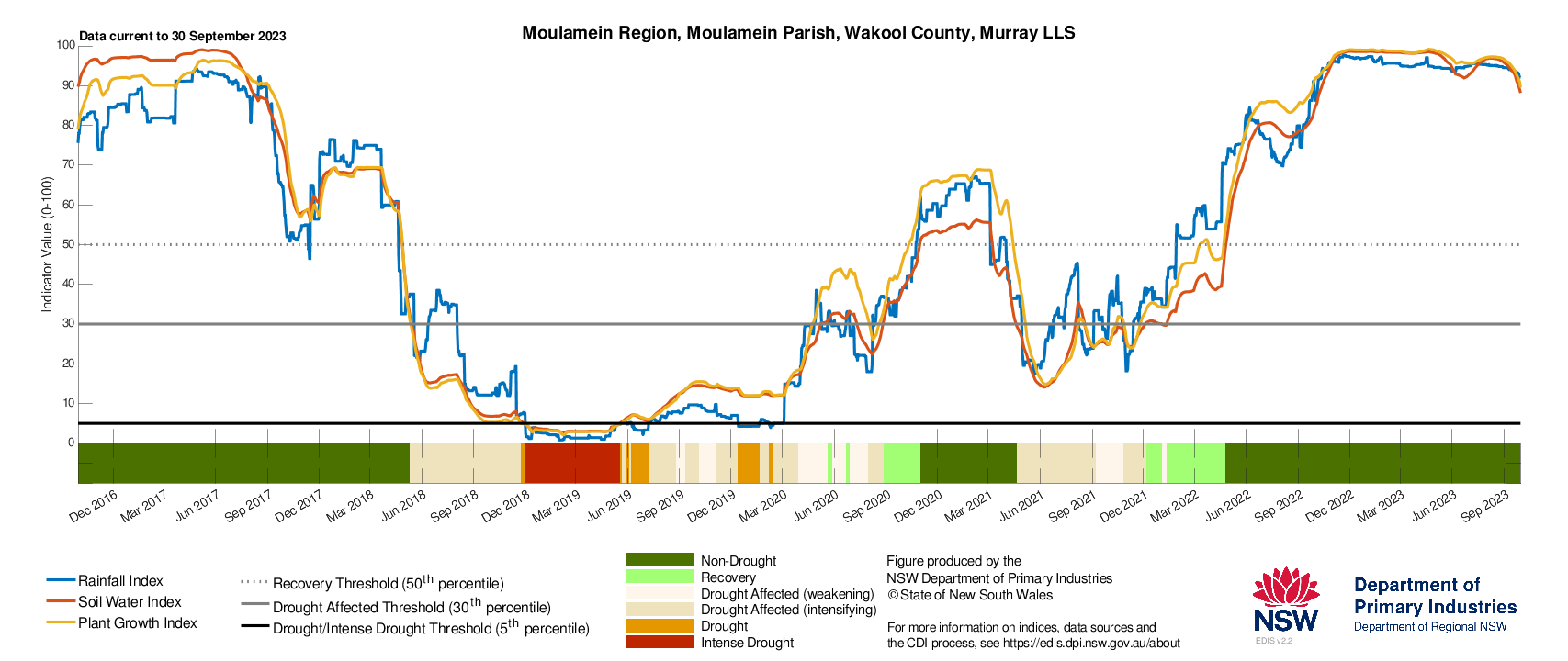
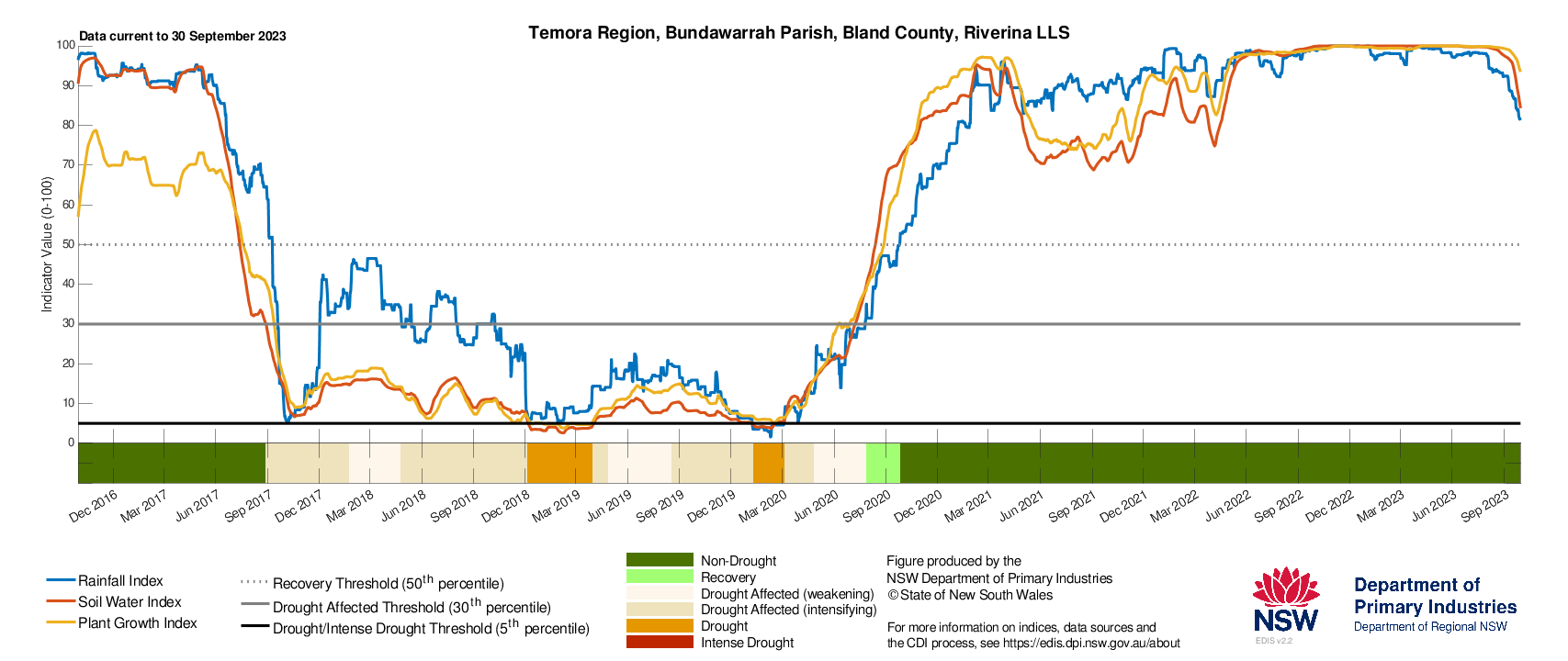
Western region
Western region producers are monitoring their local seasonal conditions and forecasts closely in line with their production systems.
- The Combined Drought Indicator (CDI, Figure 21) shows that 99% of the Western LLS region is currently in the Non-Drought category.
- September rainfall was below average for most of the Western region.
- Areas along the eastern boundary of the LLS region, particularly north west and south east of Bourke and north east of Brewarrina, have indicator values that are declining rapidly and approaching the drought thresholds.
- Due to data acquisition issues the seasonal NDVI anomaly data is only available to the end of August (Figure 19). At this time, the NDVI shows normal to above normal levels of plant greenness across the LLS region as vegetation responds to previous rainfall events.
- There are regions where the remote sensing indicates that field conditions are poor. There are localised areas of below normal vegetation condition throughout the region, particularly in the White Cliffs region and north of Broken Hill. These may be indicative of short-term drying events (3-6 months) that are not evident in a 12 months indicator like the CDI. Some of the extremely negative NDVI areas (dark brown patches) represent water.
Drought indicators remain stable for most regions.
- The Drought History charts (Figure 23) show the individual response of the drought indicators for Bourke, Ivanhoe, Wentworth, and Broken Hill.
- The indicators remain high at all locations however there has been a decline in the individual drought indicators over the past month, particularly in the Bourke region. Producers in this area should monitor their local conditions closely.
- Indicators remain high at Broken Hill, Ivanhoe and Wentworth.
- To access a Drought History chart for your Parish, visit the Seasonal Conditions Information Portal.
The Combined Drought Indicator (CDI) is a tool that monitors drought conditions across NSW. The drought categories are based on assessing the response of three drought indicators: soil water, plant growth and rainfall. The indicators track the data over the past 12 months. This shows how the indices are tracking compared to the long-term averages. The information provided in the map is aggregated to a Parish level and provides a regional assessment of conditions. Variability within and between farms is possible and this may not be reflected in the CDI map.
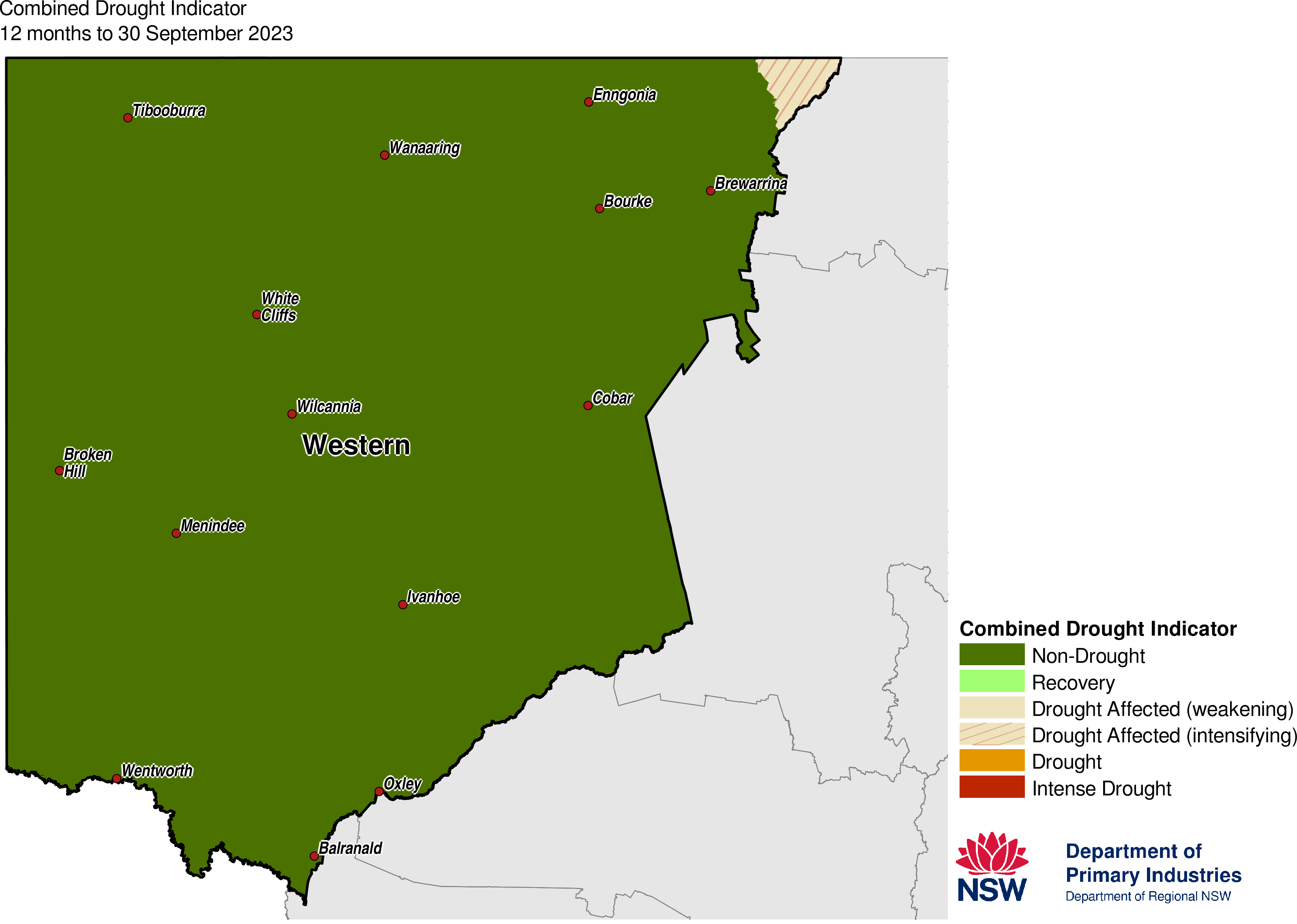
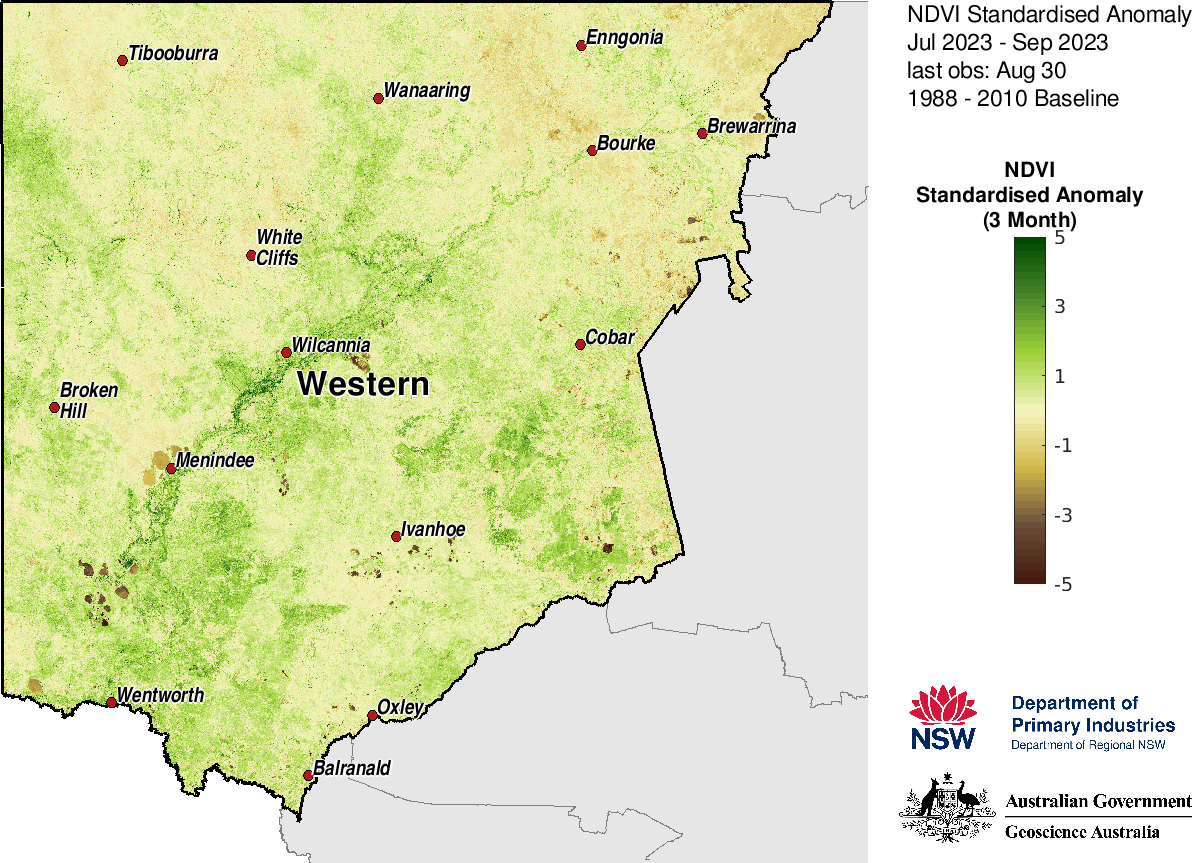
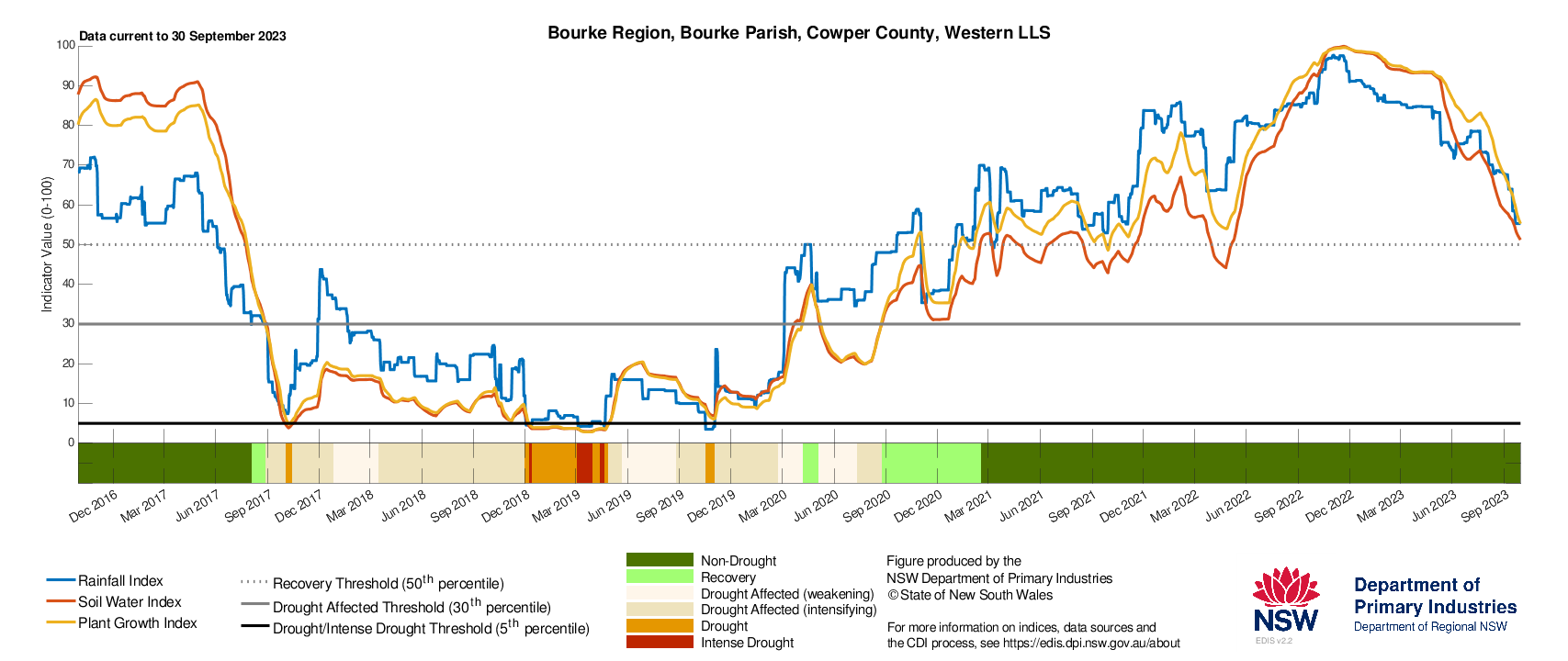
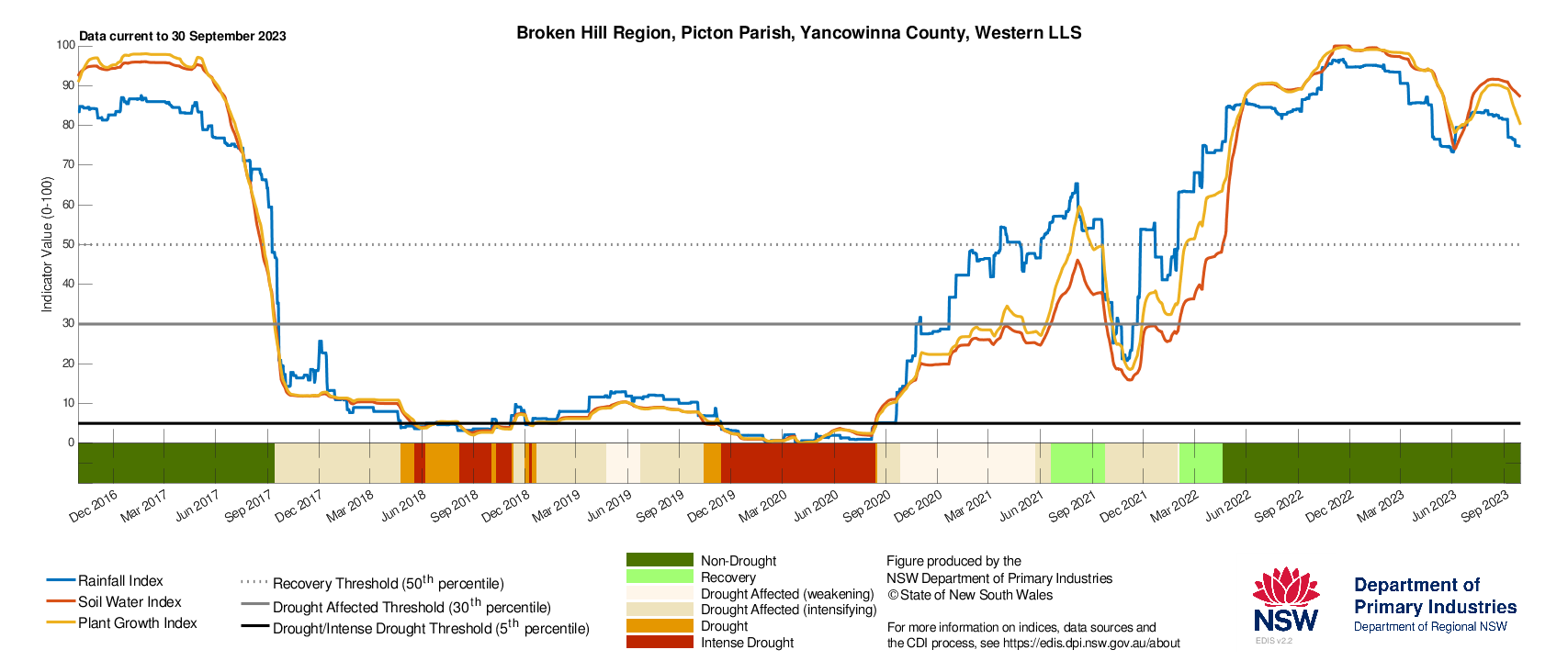
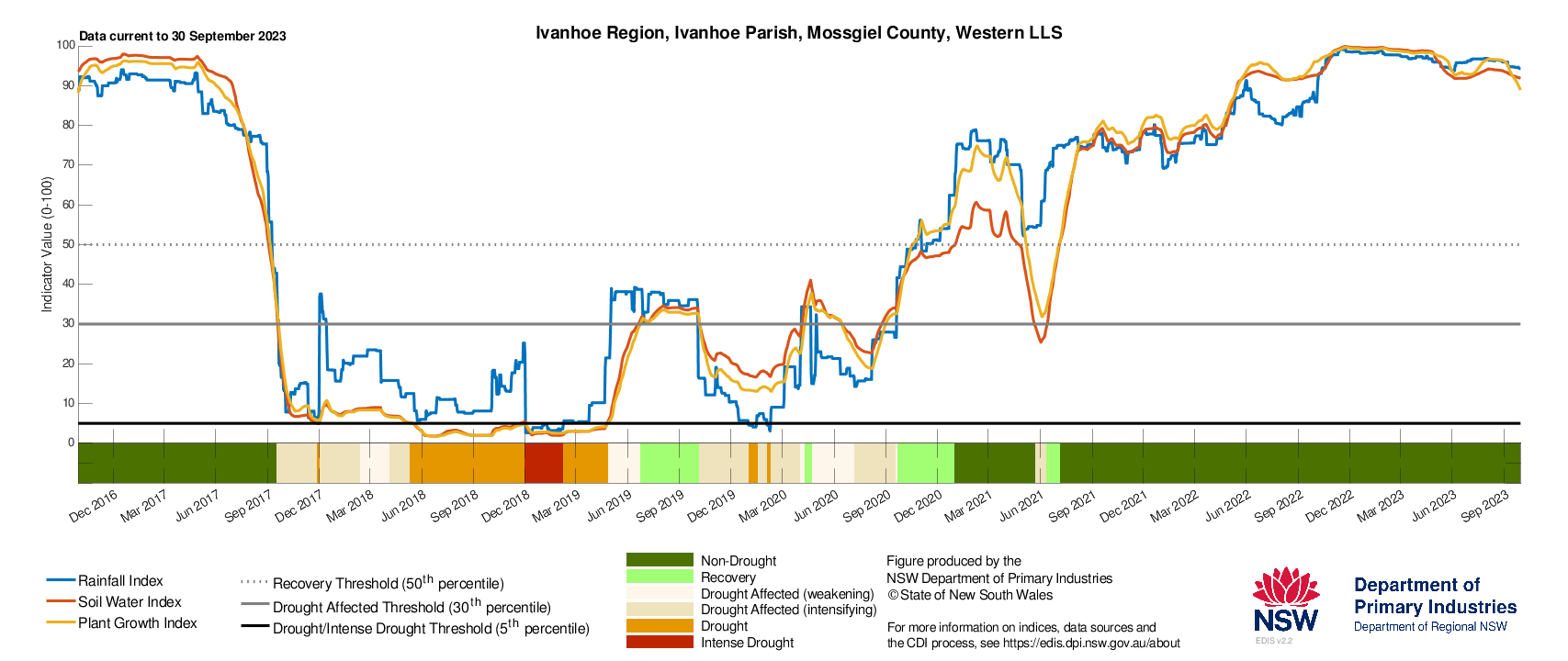
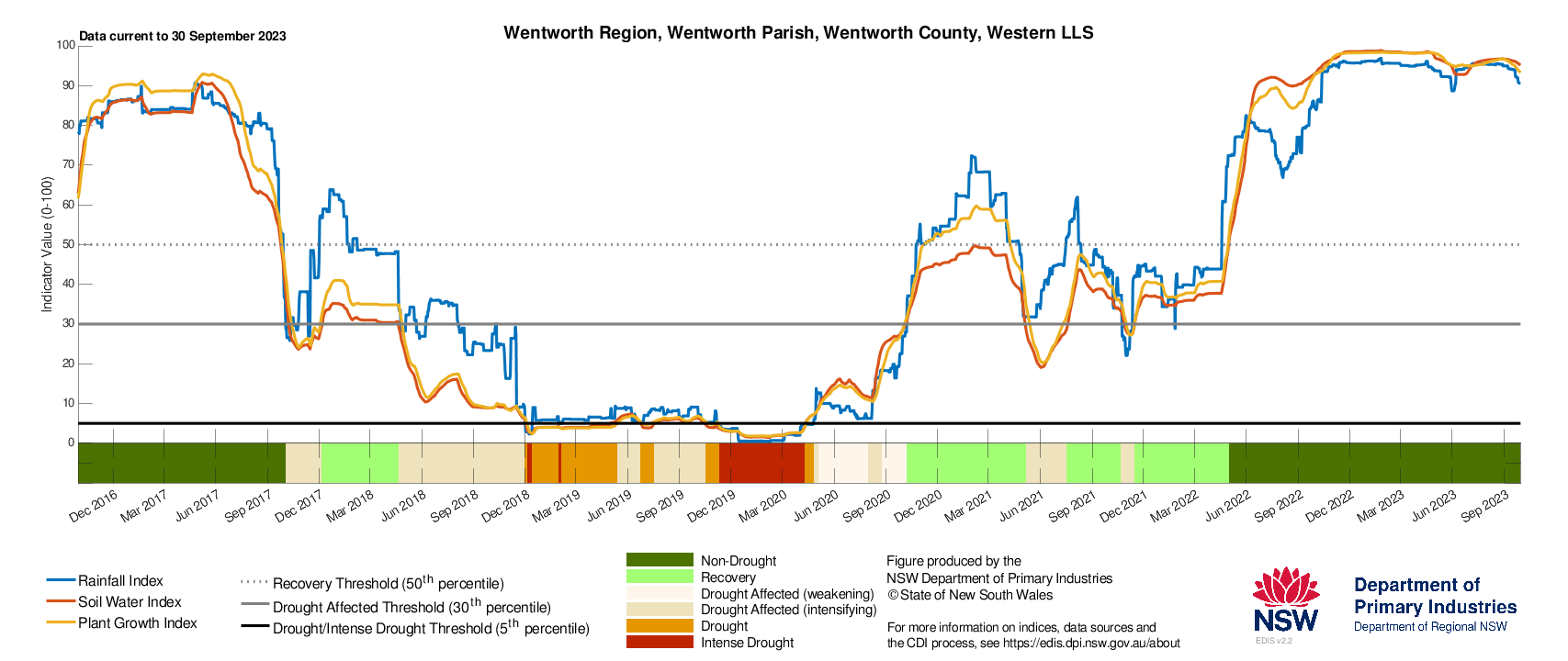
North West, Northern Tablelands and North Coast regions
The drought event continues to intensify, with producers focussing on short to medium term management strategies for their productions systems, especially livestock welfare and feed availability.
Producers continue to monitor local conditions and forecasts closely and seek advice where needed to minimise impact on production and farm operations.
- The Combined Drought Indicator (CDI, Figure 24) shows much of the North West in the Drought Affected category at the end of September.
- The North Coast region has seen conditions decline further with 100% of the region in one of the drought categories. Producers in this region should be implementing drought management strategies in line with their production systems.
- The Northern Tablelands region has experienced a decline in conditions with the area in the Drought Affected category expanding since the last Update.
- September rainfall was below to very much below average for the three Local Land Services regions, which is contributing to the decline in conditions.
- Due to data acquisition issues the seasonal NDVI anomaly data is only available to the end of August (Figure 19). At this time, the NDVI shows there was generally normal to above normal levels of plant greenness across eastern parts of the region. Large parts of the North West LLS region were experiencing lower than normal levels of plant greenness. The NSW DPI continues to closely monitor conditions in these regions.
Drought indicators are in decline in all regions consistent with the onset or continuation of a drought event.
- The Drought History charts (Figure 26) show the individual response of the drought indicators for Tenterfield, Moree, Walgett, and Lismore.
- Consistent with an intensifying drought event the regions around Grafton and Clarence Valley are in the Intense Drought category with adjacent parishes close to the thresholds that trigger Intense Drought.
- There has been a continued, sharp decline in the indicators at Tenterfield, Moree and Walgett, with a transition into the Drought Affected category since the last Update.
- Indicators have declined further at Lismore, with Lismore and Tenterfield likely to transition into the Drought category in the coming weeks.
- To access a Drought History chart for your Parish, visit the Seasonal Conditions Information Portal.
The Combined Drought Indicator (CDI) is a tool that monitors drought conditions across NSW. The drought categories are based on assessing the response of three drought indicators: soil water, plant growth and rainfall. The indicators track the data over the past 12 months and shows how the indices are tracking compared to the long-term averages. The information provided in the map is aggregated to a Parish level and provides a regional assessment of conditions. Variability within and between farms is possible and this may not be reflected in the CDI map.
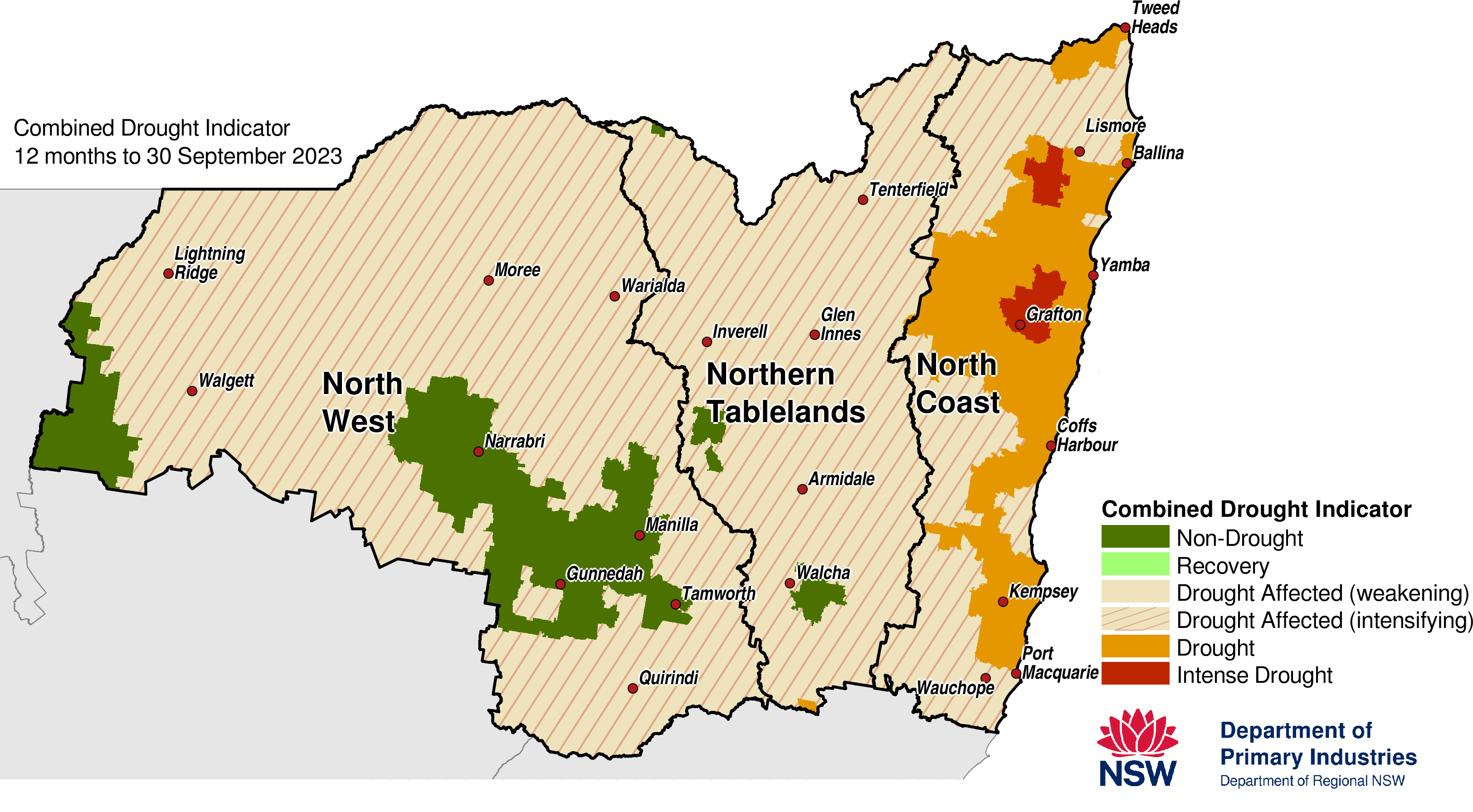
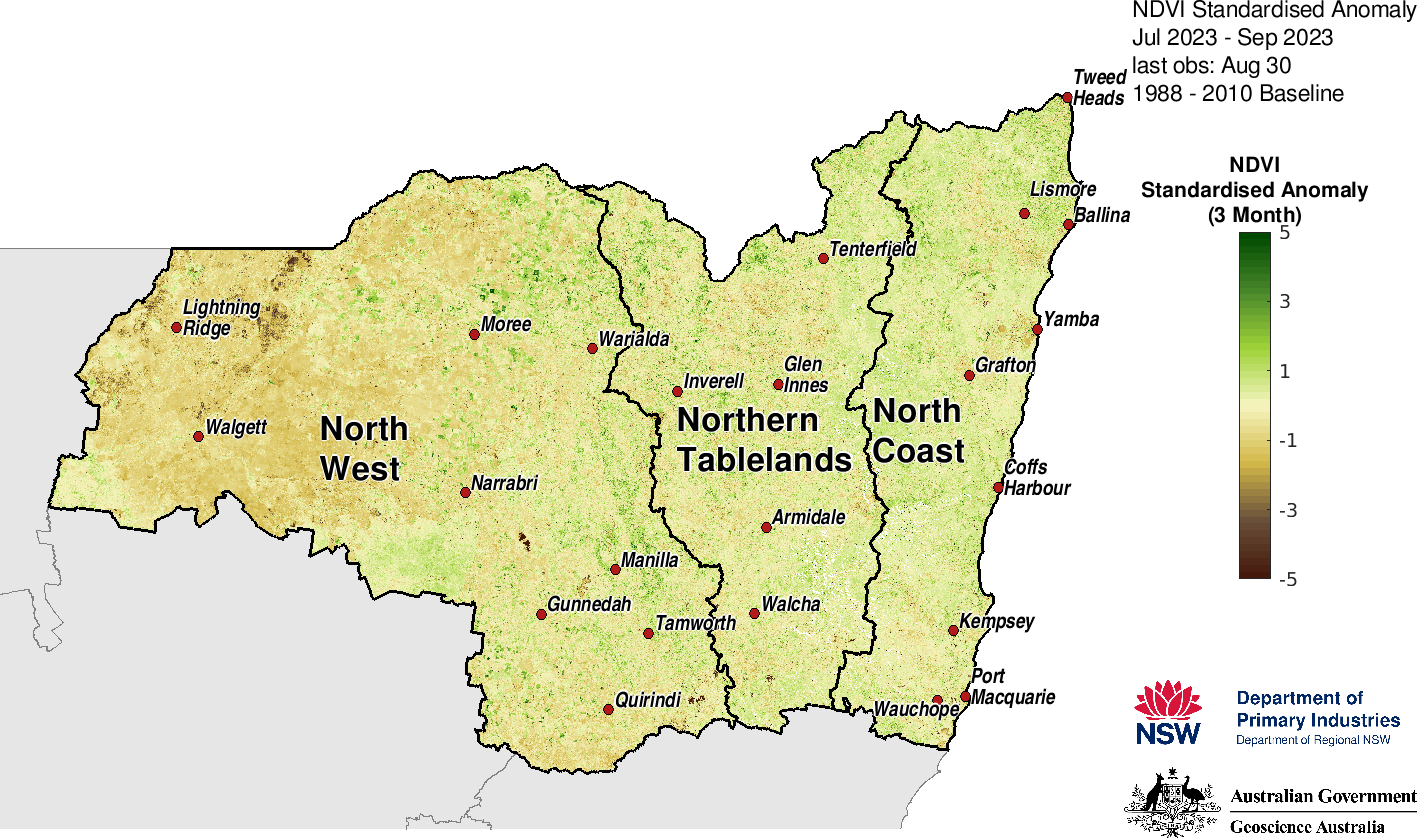
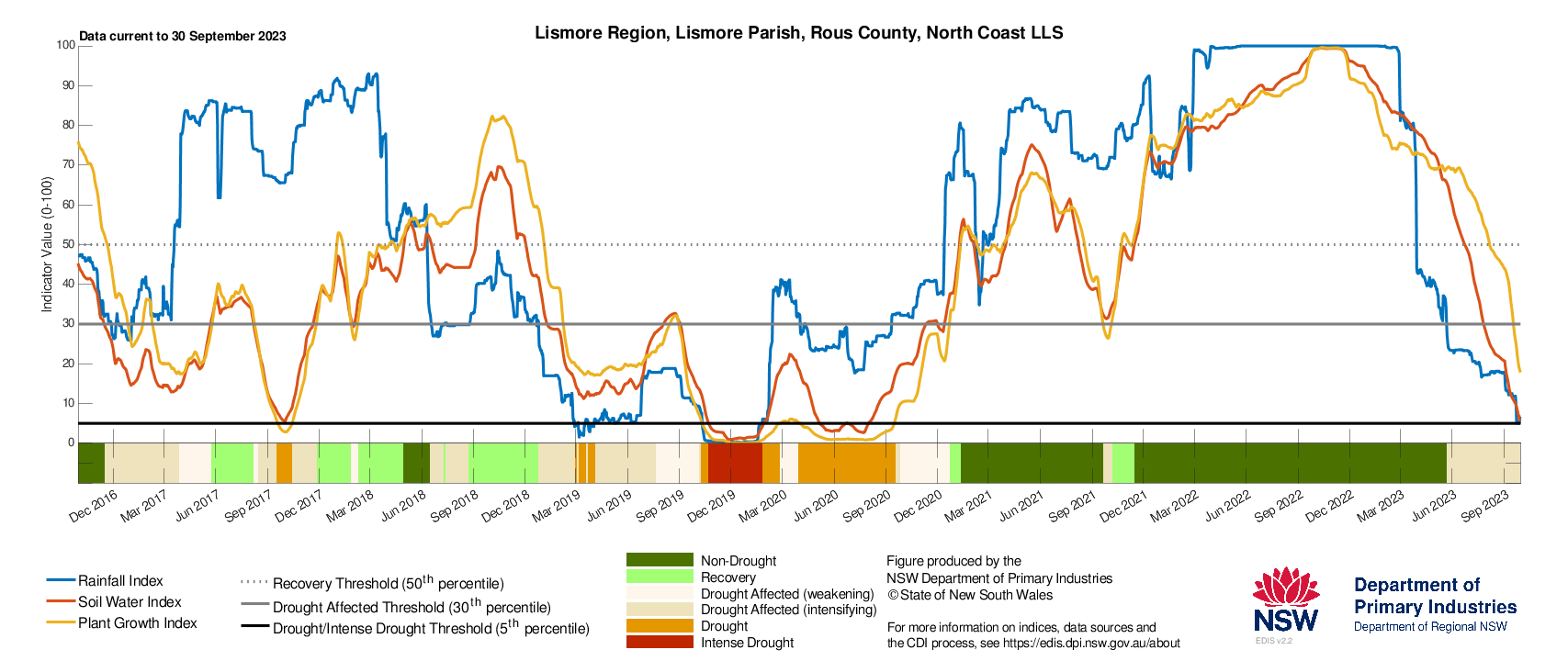
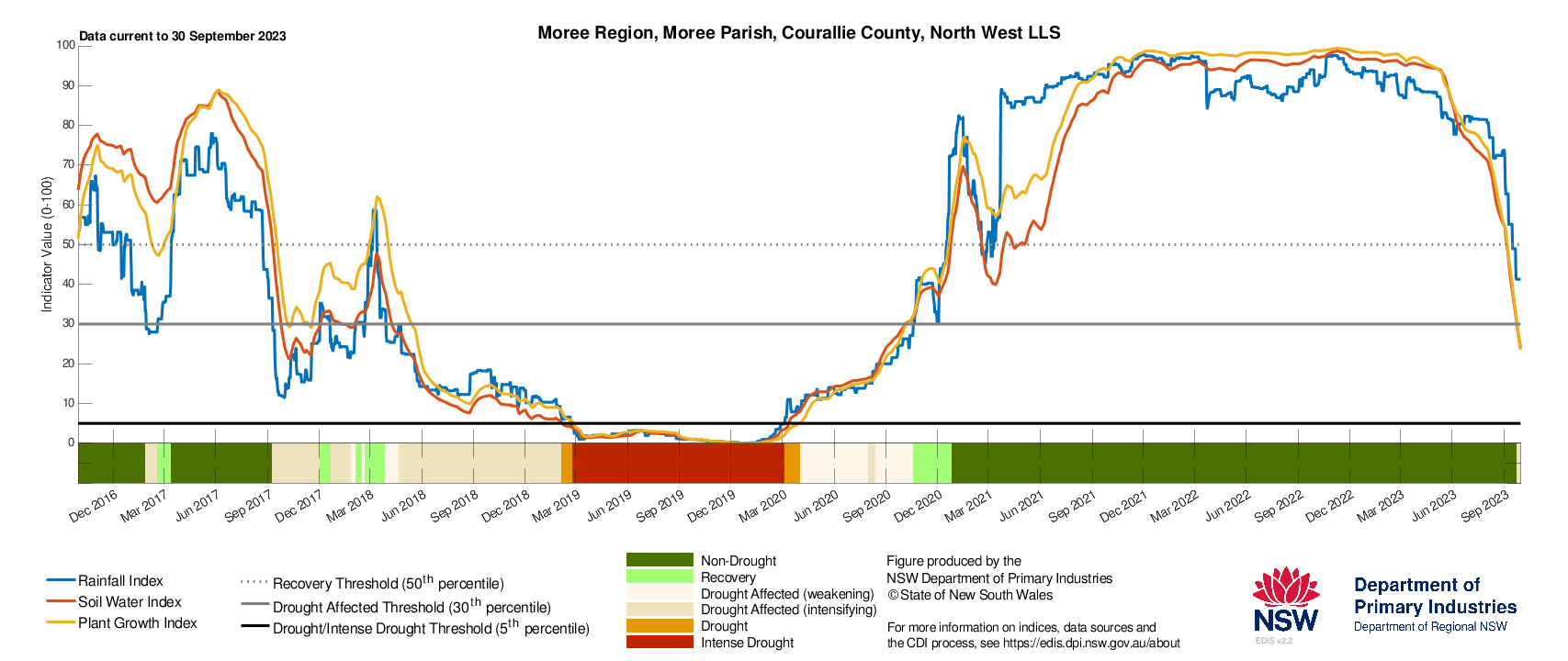
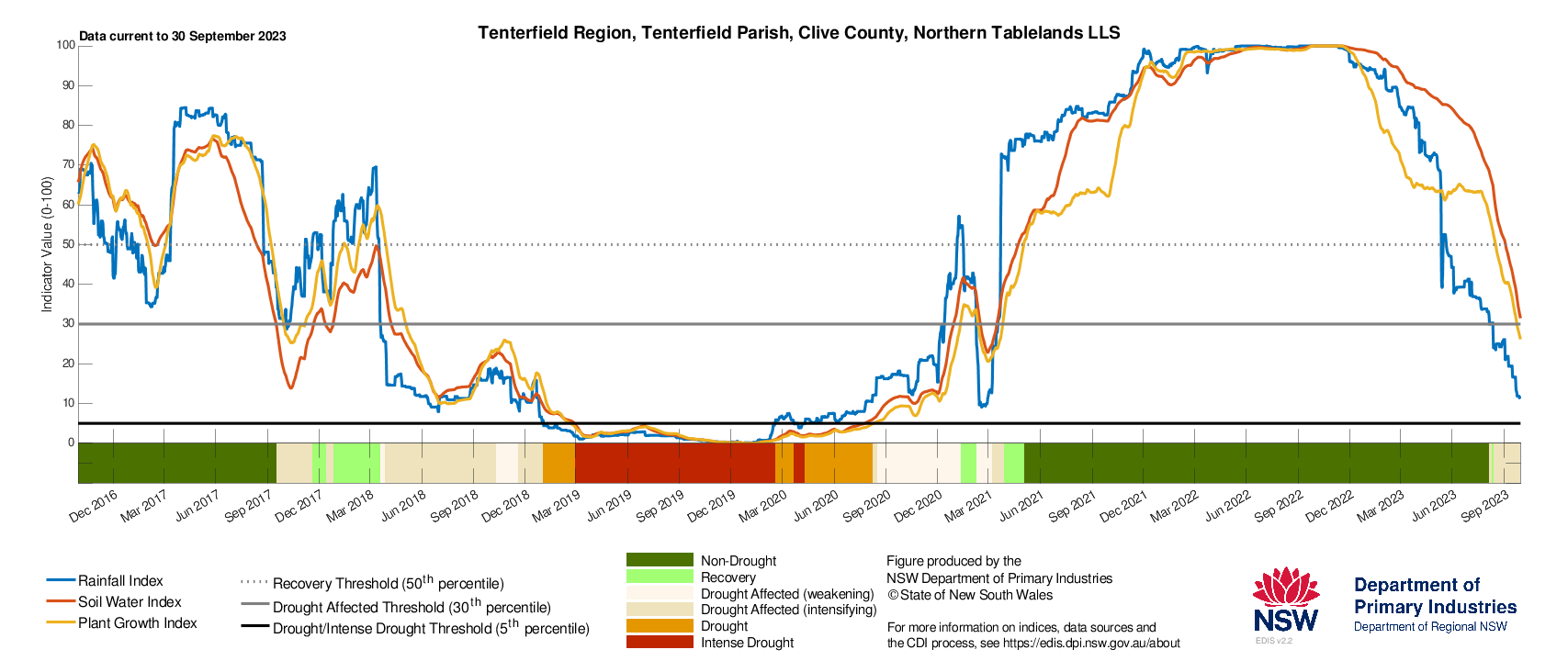
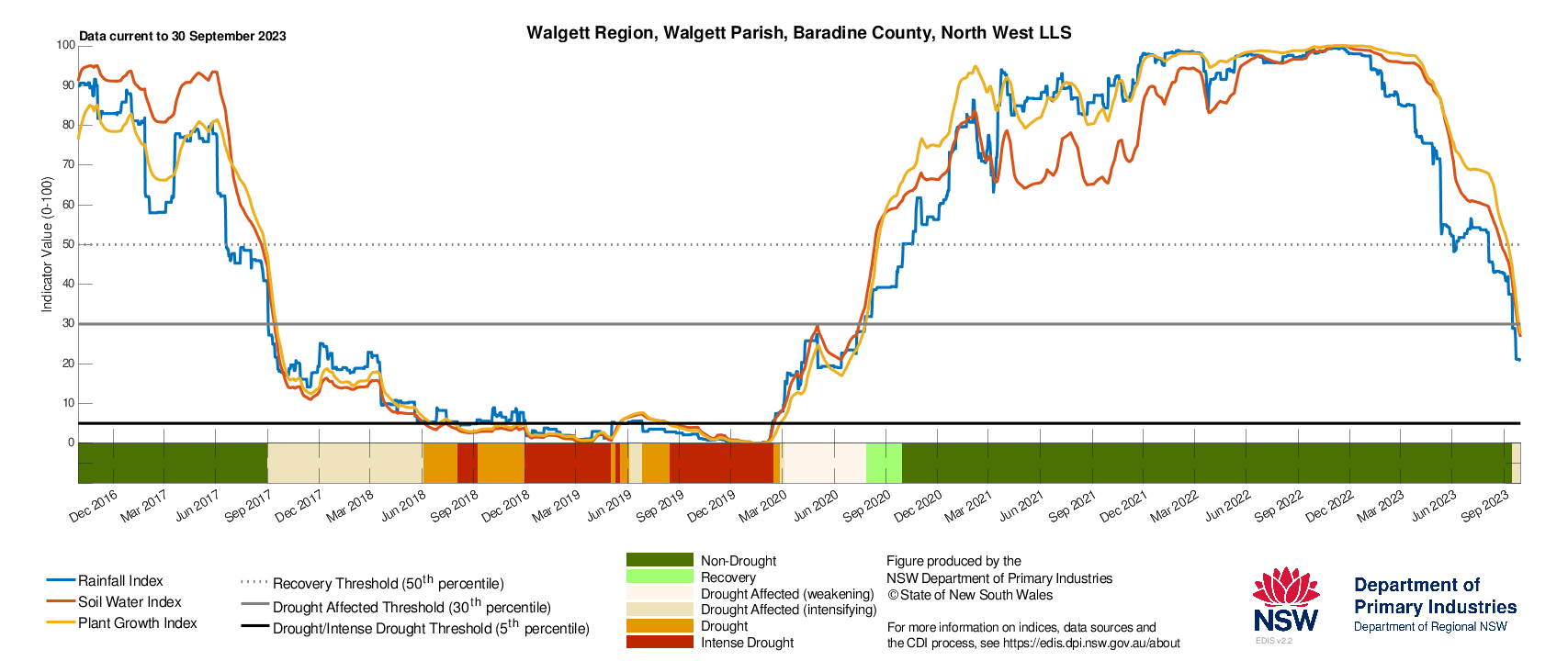
Central Tablelands, Central West, Hunter and Greater Sydney regions
Hunter region is experiencing a drought event with producers focussing on short to medium term management strategies for their productions systems, especially livestock welfare and feed availability and should seek advice where needed.
Producers in the Central West, Central Tablelands and Greater Sydney continue to monitor their local seasonal conditions and forecasts closely. They continue to review management strategies to minimise impact on production and farm operations.
- The Combined Drought Indicator (CDI; Figure 27) shows that parts of Central West and Central Tablelands Local Land Services (LLS) regions continue to experience Non-Drought conditions at the end of September. There are areas in these regions where conditions have declined and have transitioned to the Drought Affected category.
- Conditions in the Greater Sydney LLS region have declined since the last Update, with much of the region in a drought category.
- The Hunter LLS region continues to experience a decline in conditions. At the end of September, 100% of the Hunter LLS region is in one of the drought categories. The CDI indicators show this region has experienced 6-9 months of dry conditions. Further decline in conditions is likely without any substantial rainfall. Producers in this region continue to implement drought management strategies in line with their production systems.
- September rainfall was below to very much below average for most of the Central Tablelands, Hunter and Greater Sydney LLS regions.
- Due to data acquisition issues the seasonal NDVI anomaly data is only available to the end of August (Figure 19). At this time, the NDVI shows that levels of plant greenness were variable across the regions. Large parts of the LLS regions were experiencing normal to above average plant greenness. Large area of the Central West and Upper Hunter were experiencing below average levels of greenness for the July to August period. Some of the extremely negative NDVI areas (dark brown patches) represent water.
- The available remote sensing information (NDVI) highlights considerable variability within the region that is in the Drought Affected category. For example, the region between Warren, Coonamble and Coonabarabran has isolated patches of moderate to high plant greenness, indicative of feed (‘green pick’) available for livestock. It also has areas of very poor condition with low levels of ground cover, and farmers have reported that they have begun supplementary feeding. This type of variability and complexity in field conditions is common as the landscape continues to dry.
- NSW DPI continues to closely monitor conditions in these regions.
Drought indicators continue to decline in the Hunter consistent with a drought event. Other regions are seeing a decline in the drought indicators in some areas.
- The Drought History charts (Figure 29) show the individual response of the drought indicators for Cowra, Condobolin and Scone.
- There has been a further decline in the CDI indicators at Scone with the region in Drought Affected category.
- The indicators remain high at Cowra and Condobolin however there has been a decline in the individual drought indicators over the past month, Producers in these areas should monitor conditions in line with their production systems.
- To access a Drought History chart for your Parish, visit the Seasonal Conditions Information Portal.
The CDI is a tool that monitors drought conditions across NSW. The drought categories are based on assessing the response of three drought indicators: soil water, plant growth and rainfall. The indicators track the data over the past 12 months and show how the indices are tracking compared to the long-term averages. The information provided in the map is aggregated to a Parish level and provides a regional assessment of conditions. Variability within and between farms is possible and this may not be reflected in the CDI map.
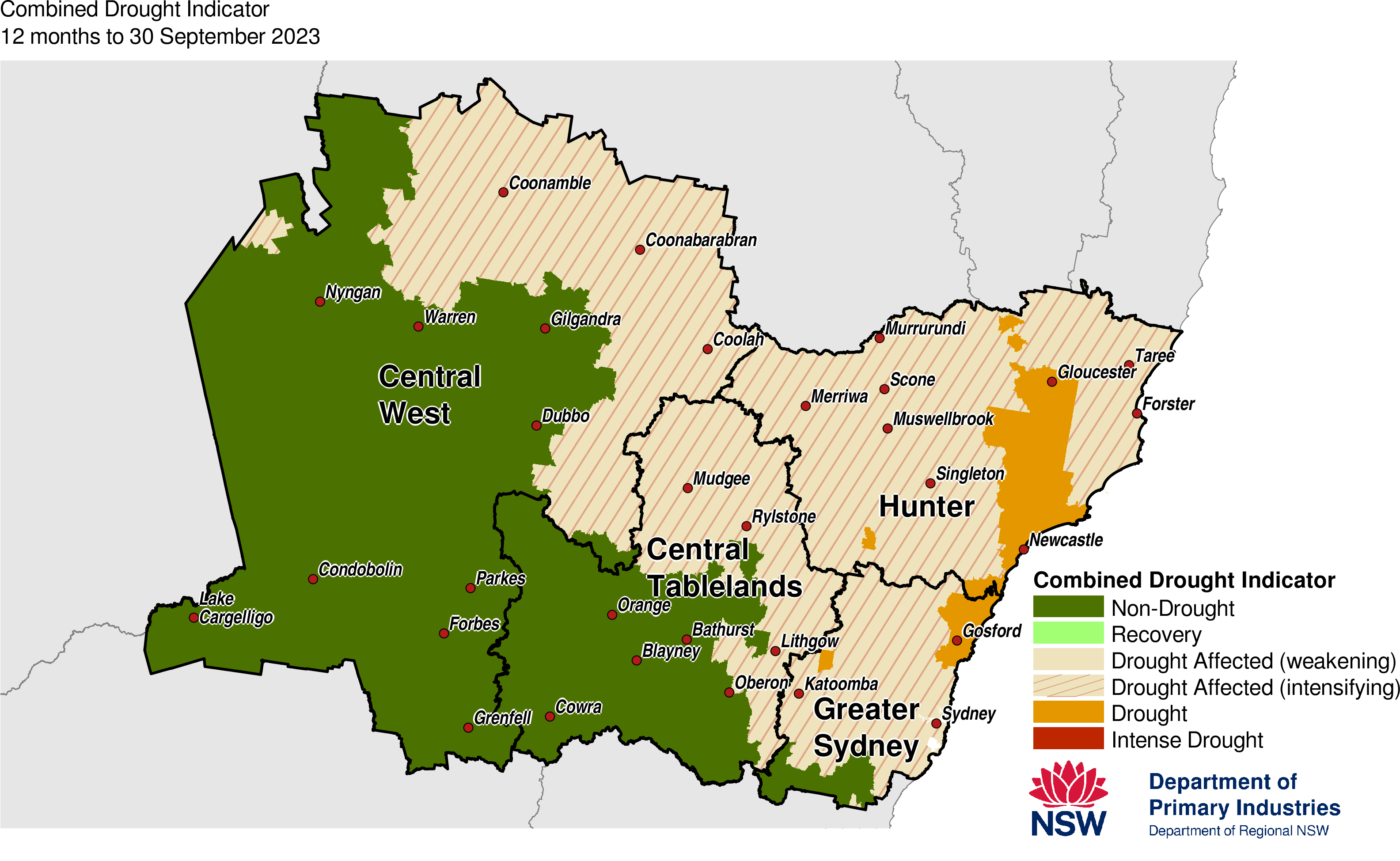
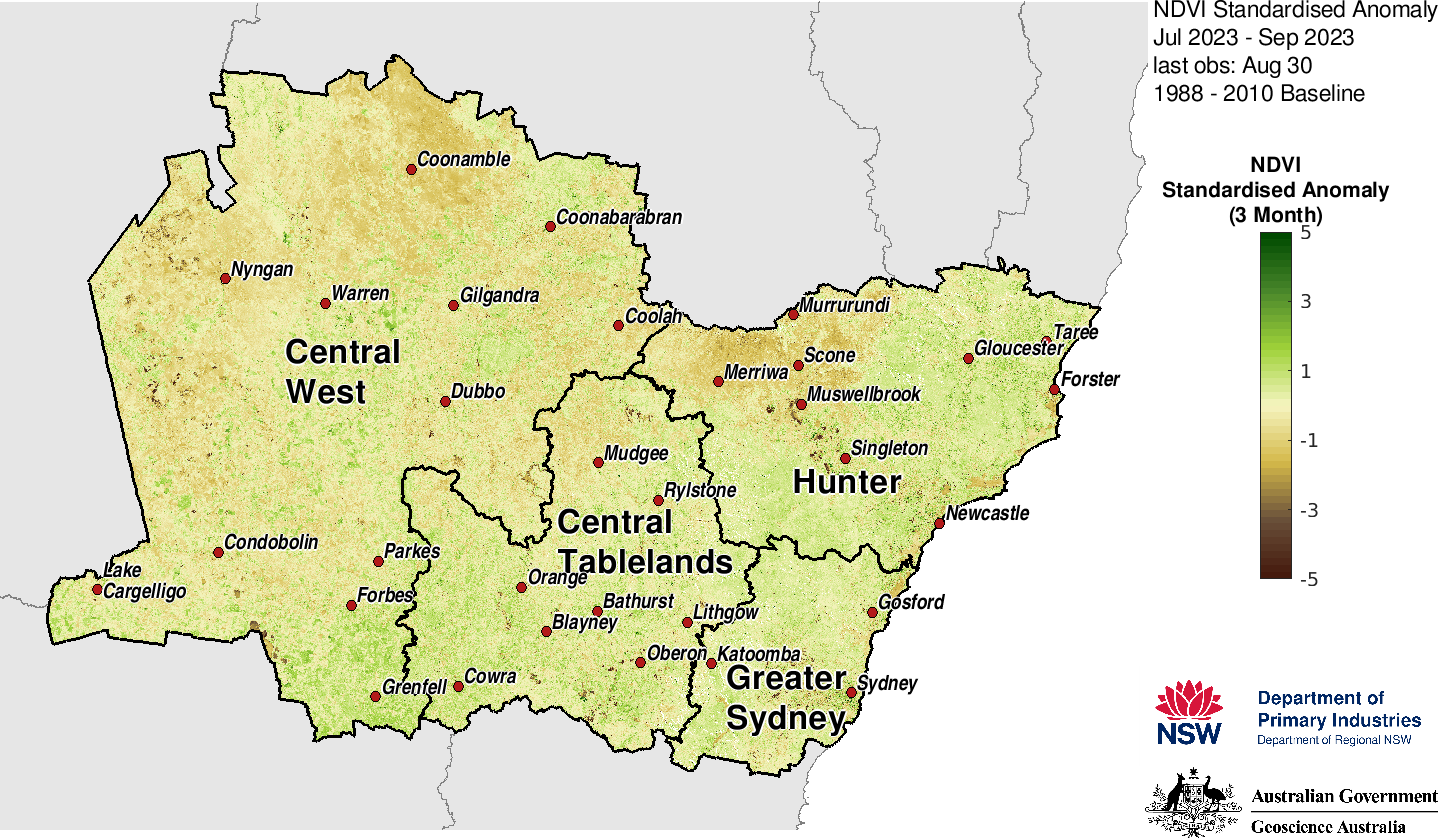
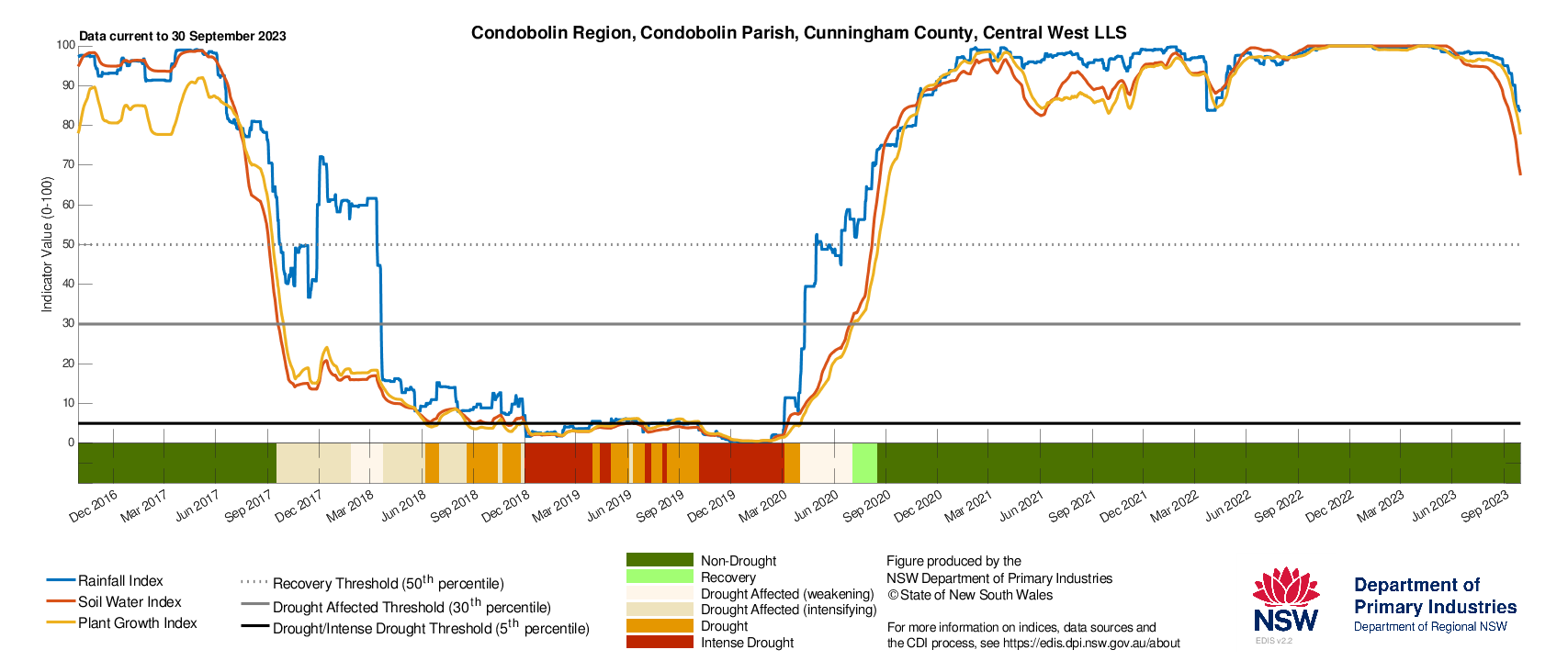
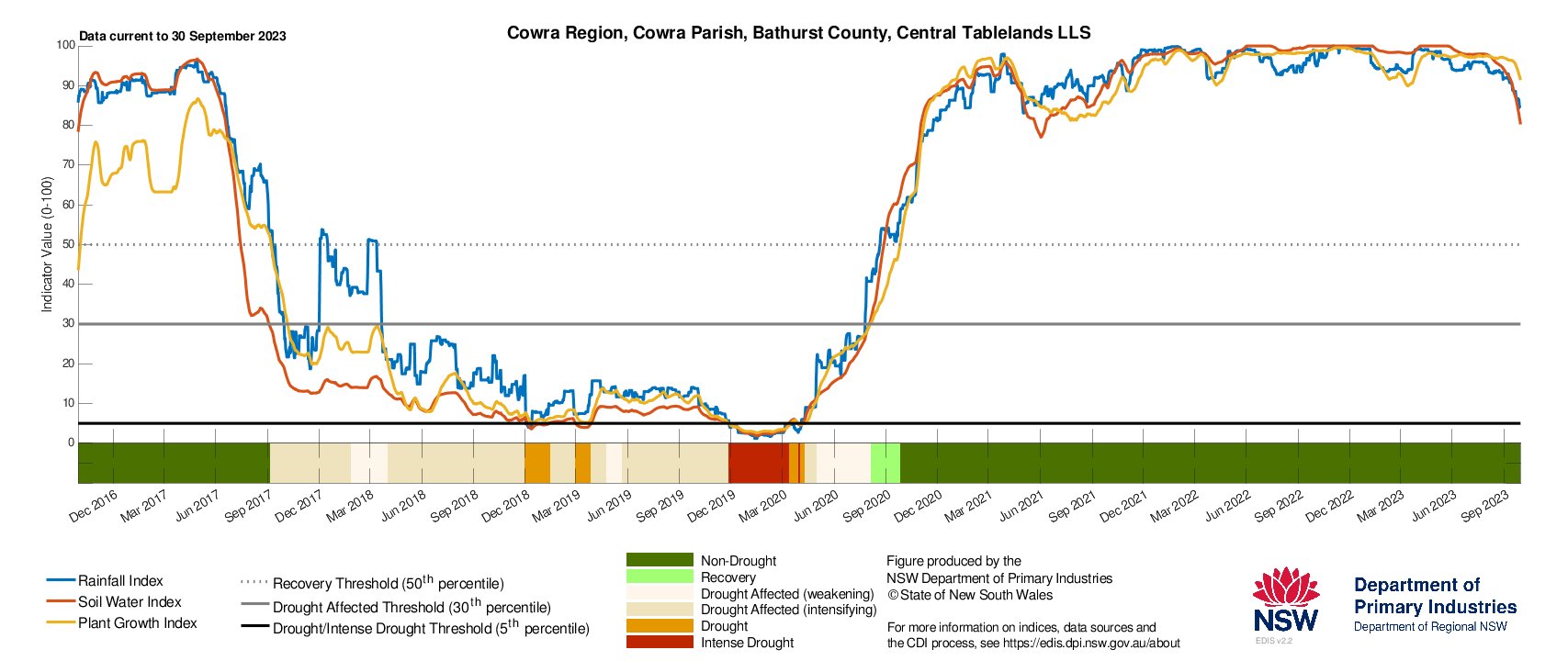
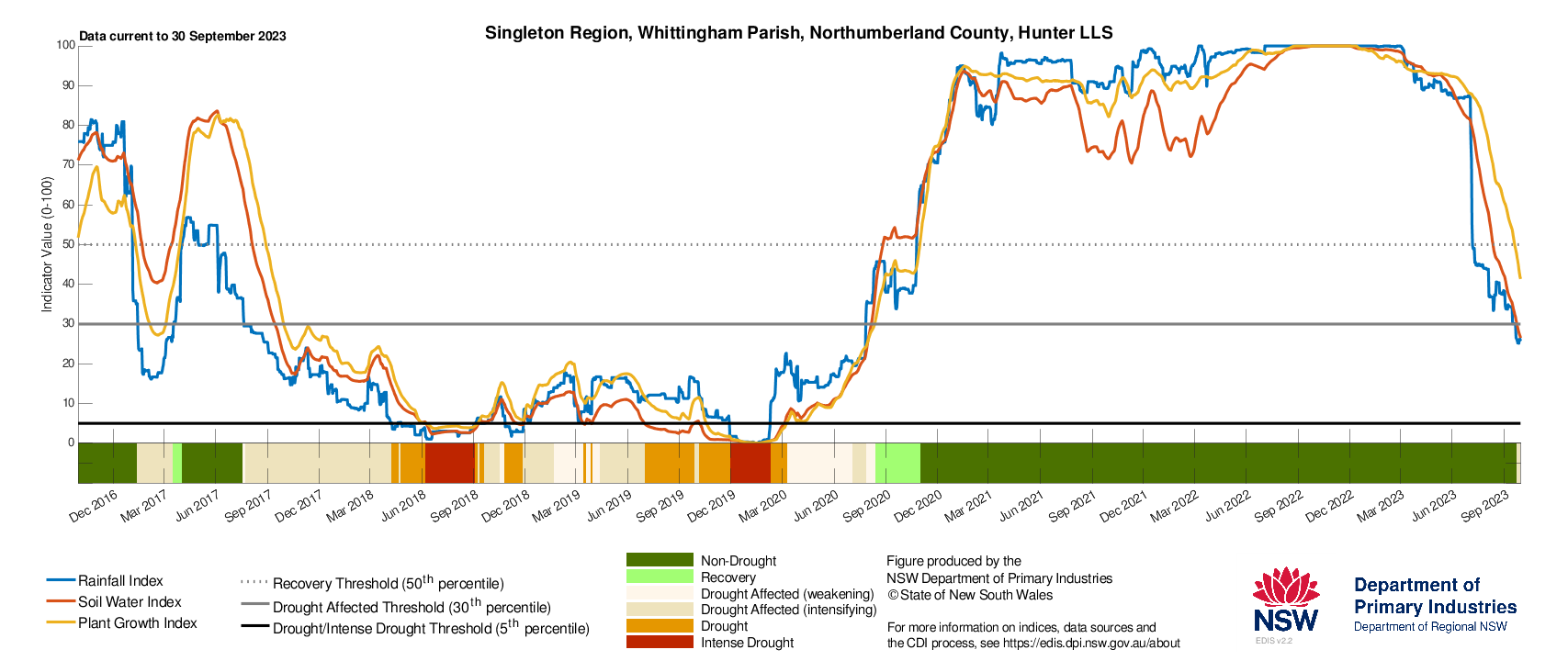
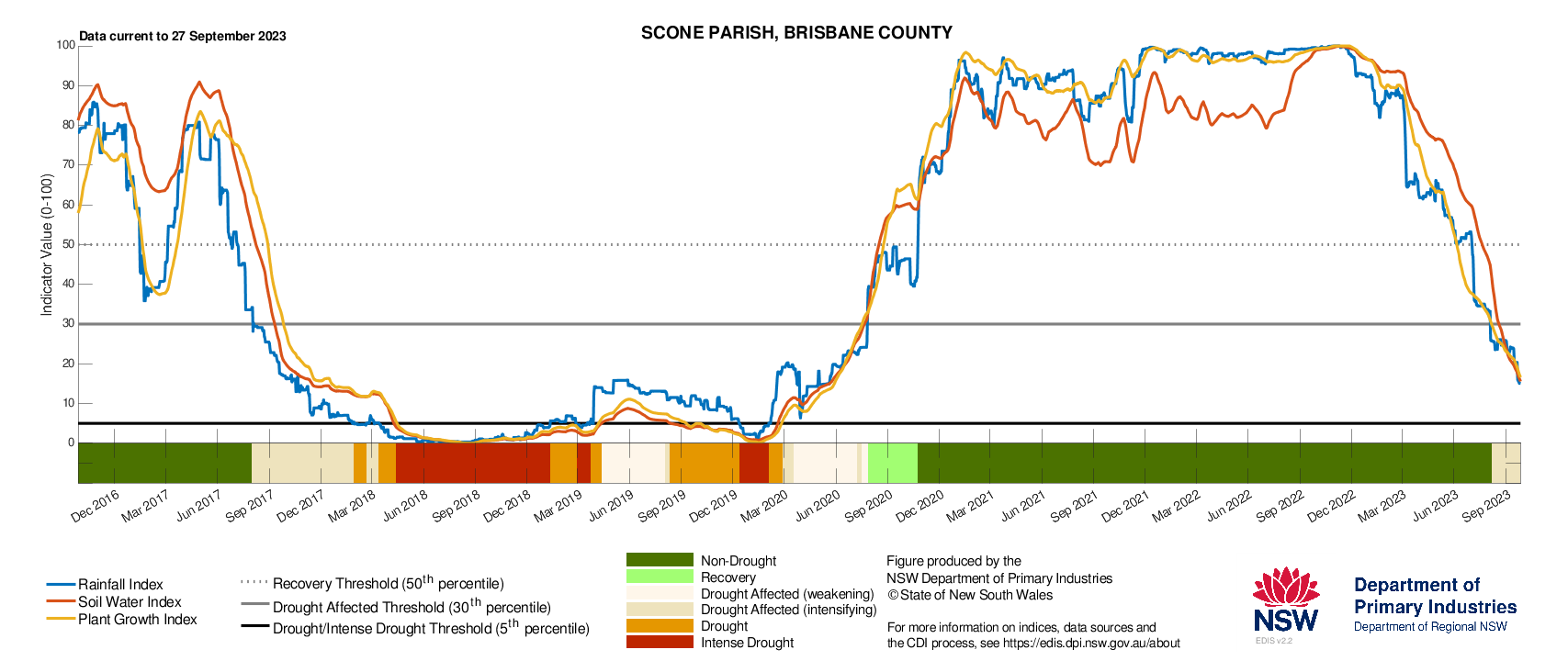
South East region
Parts of the South East region are experiencing an intensifying drought event and producers are focussing on short to medium term strategies for their productions systems, including irrigation, especially to manage livestock welfare and feed availability.
All producers in the region continue to monitor their seasonal conditions and forecasts closely and seek advice as needed.
- The Combined Drought Indicator (CDI, Figure 30) shows varies conditions in the South East Local Land Services region. Although large areas are in the Non-Drought category, the area in the Drought Affected category continues to expand.
- September rainfall was very much below average for most of the region.
- Due to data acquisition issues the seasonal NDVI anomaly data is only available to the end of August (Figure 19). At this time, the NDVI shows near normal to above average levels of plant greenness across most of the region. There were areas that have below average levels of greenness such as the Bega Valley, the region southeast of Jindabyne to Bombala and parts of the greater Goulbourn district. Some of the extremely negative NDVI areas (brown patches) represent water. The white patches represent missing data.
- The NSW DPI continues to closely monitor conditions in this region.
Drought indicators remain stable for inland areas, indicating a positive outlook for production. In contrast, the drought indicators are continuing to rapidly decline in parts of the coast and hinterland.
- The Drought History charts (Figure 32) show the individual response of the drought indicators at Bega, Cooma and Goulburn.
- Although still high, there has been a decline in the indicators at Cooma and Goulburn. Producers in these areas should monitor local conditions closely.
- There has been a continued decline in all indicators at Bega and is likely to transition into the Drought category in the coming weeks.
- Producers in the Bega region should be implementing drought management strategies in line with their production systems.
- To access a Drought History chart for your Parish, visit the Seasonal Conditions Information Portal.
The Combined Drought Indicator (CDI) is a tool that monitors drought conditions across NSW. The drought categories are based on assessing the response of three drought indicators: soil water, plant growth and rainfall. The indicators track the data over the past 12 months and shows how the indices are tracking compared to the long-term averages. The information provided in the map is aggregated to a Parish level and provides a regional assessment of conditions. Variability within and between farms is possible and this may not be reflected in the CDI map.
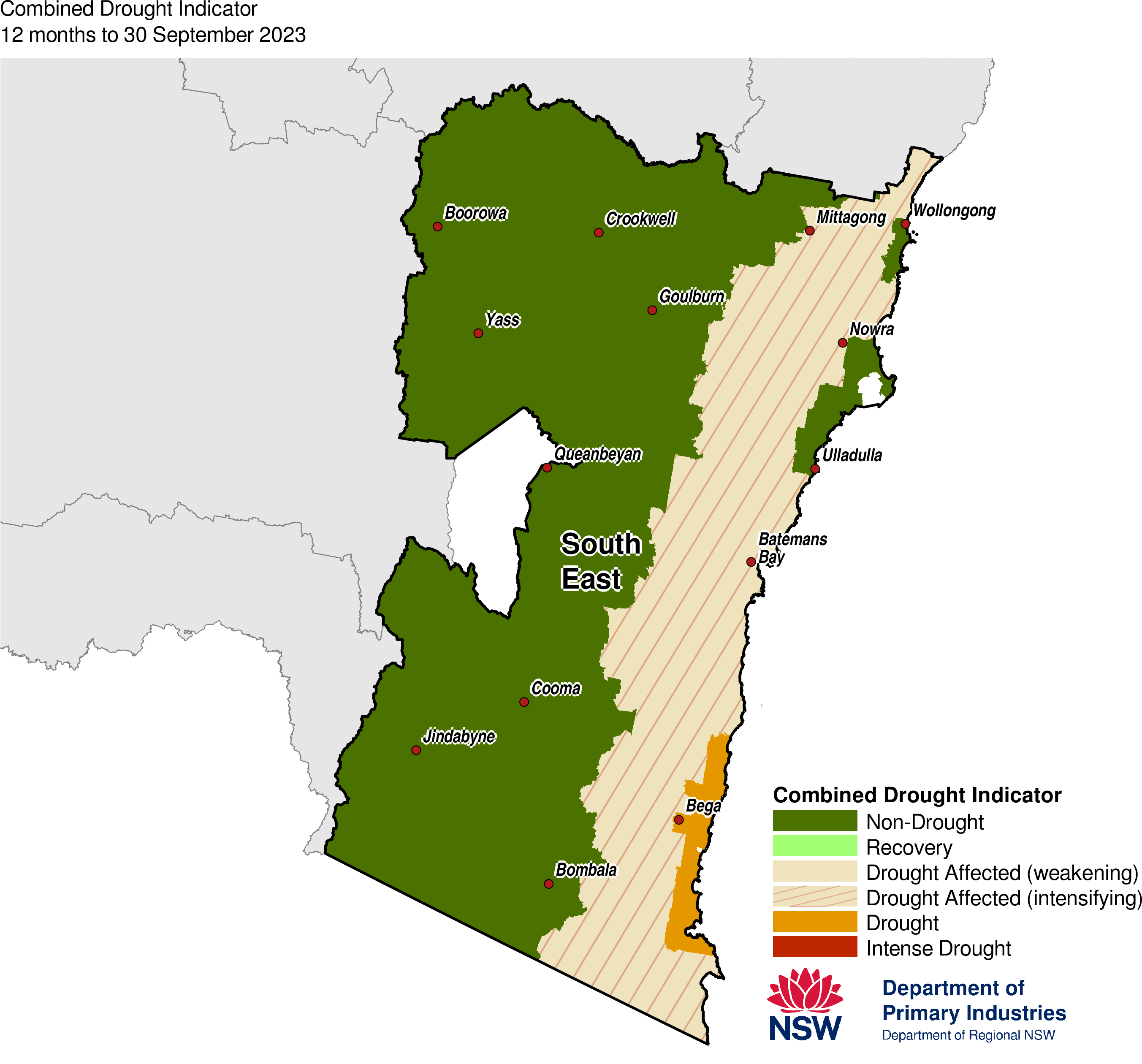
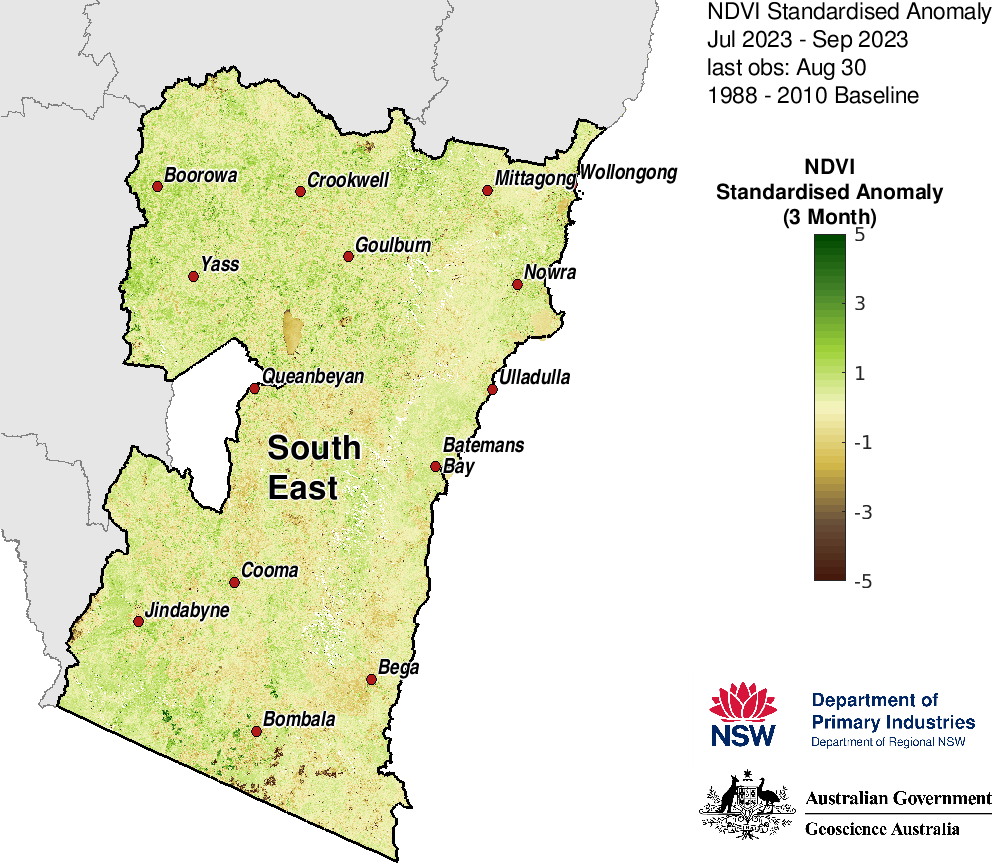
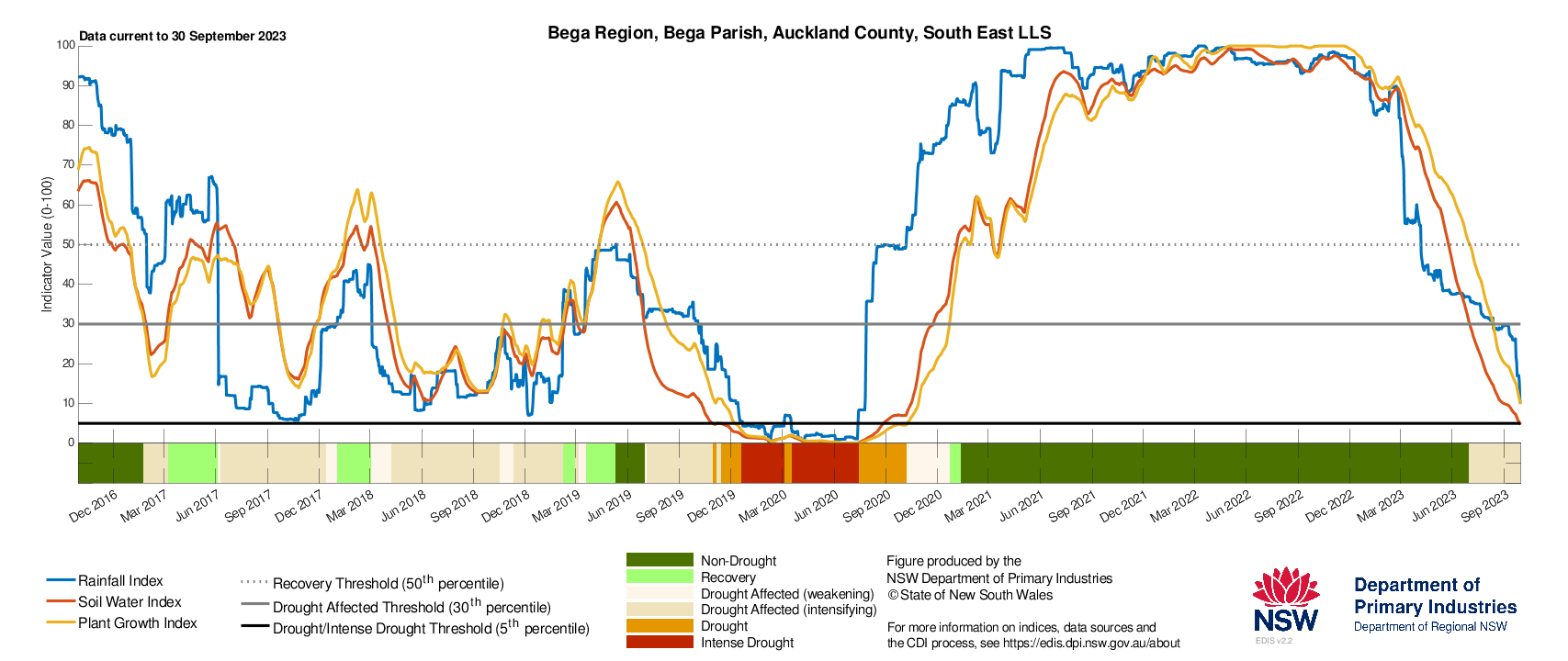
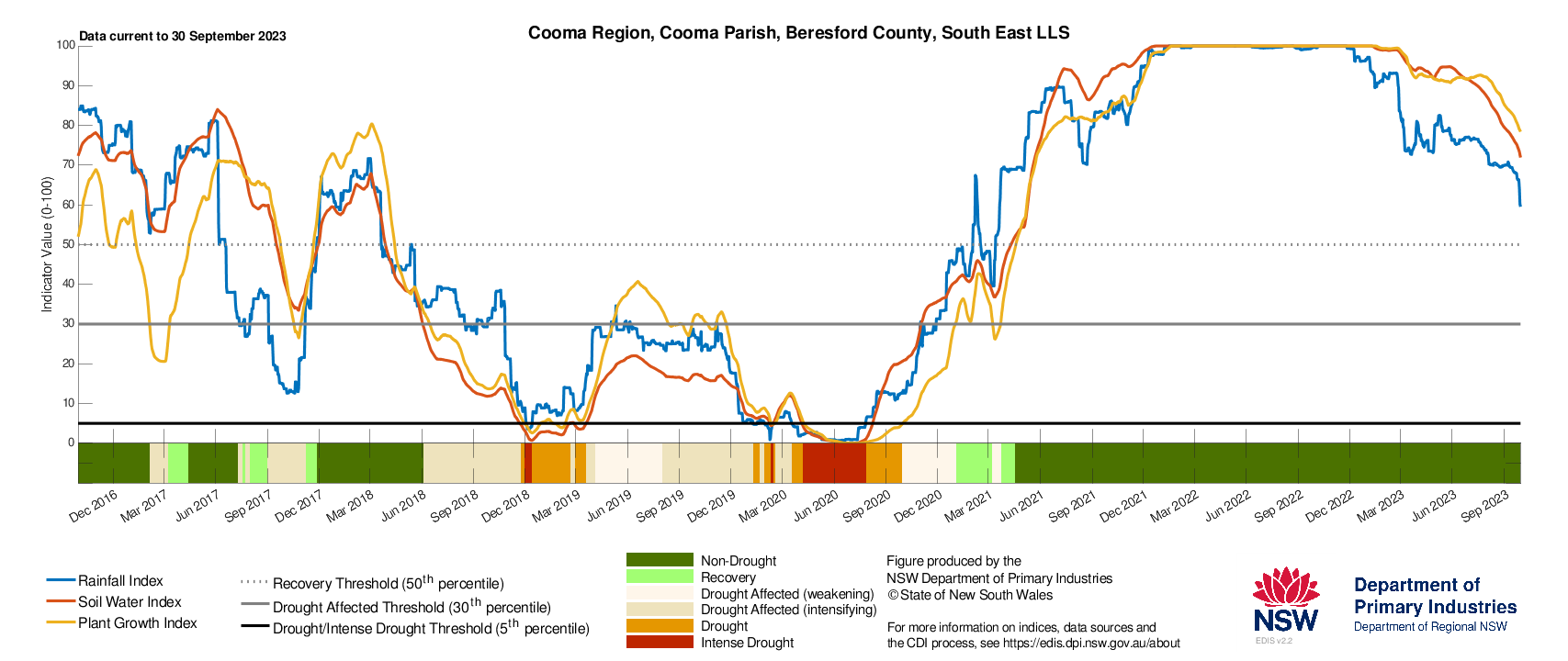
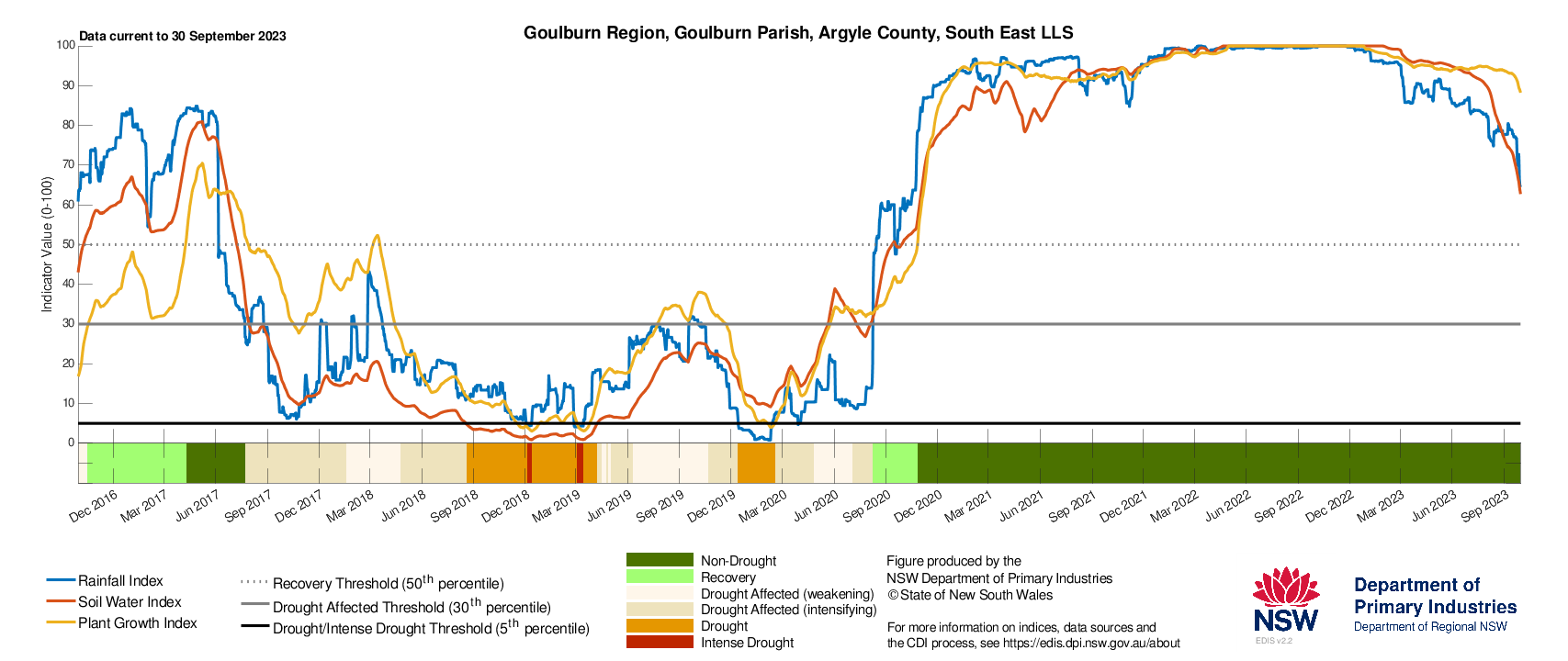
How does it work?

The Combined Drought Indicator is one source of information that informs policy and Government responses to changing seasonal conditions, including drought. The map provides a snapshot of conditions at a point in time and is not used to determine eligibility for drought assistance measures offered by the NSW Government.
Much of the information in the Seasonal Conditions Report is sourced from the NSW DPI Enhanced Drought Information System (EDIS)™. The EDIS system is subject to an intensive ground truthing process. For more information, visit the interactive website via droughthub.nsw.gov.au.
EDIS is an ongoing project aimed at improving the quality and timeliness of efforts to monitor conditions across the state. Key features of the system are:
- It tracks drought by using four indicators; rainfall, soil water, plant growth, as well as tracing rainfall trends. Agronomic conditions have equal value to rainfall recorded at meteorological stations.
- The Combined Drought Indicator (CDI) brings this information together and has been designed to characterise developing drought conditions. The key purpose for building the CDI was as a drought early warning system.
- The rainfall, soil moisture and plant growth indicators in EDIS account for conditions over a 12-month window. This provides a compromise between a highly sensitive indicator (e.g. six months) and a less sensitive indicator (e.g. 24 months).
- Climate and remote sensing data drive the information system at a high resolution, but the CDI is reported at a Parish level.
- Because of its configuration and purpose, there will be differences to the indicator used in the National Drought Monitoring Framework (the Australian Rainfall Deficiency Analyser) which relies on rainfall alone.
- The CDI has three drought categories that characterise NSW according to drought intensity as well as the main drivers of a drought event (meteorological, hydrological and agronomic). DPI considers areas Drought Affected to be experiencing a drought event.
- The Drought Affected category encompasses a wide range of conditions from the very early stages of drought entry through to a drought event becoming intense. This enables the drought monitoring system to detect a drought event early. It is also possible to stay in the Drought Affected category for some period of time.
The way in which the indicators are combined to form the CDI is described in Table 1 below.
Table 1: Description of the Combined Drought Indicator framework
CDI Phase | Technical definition | Description - typical field conditions |
|---|---|---|
Intense Drought | All three indicators (rainfall, soil water, plant growth) are below the 5th percentile | Ground cover is very low, soil moisture stores are exhausted and rainfall has been minimal over the past 6-12 months. |
Drought | At least one indicator is below the 5th percentile | Conditions may be very dry, or agronomic production is tight (low soil moisture or plant growth). It is possible to be in Drought when there has been some modest growth, or a few falls of rain. |
Drought Affected (intensifying) | At least one indicator is below the 30th percentile and the rainfall trend is negative over the past 90 days. | Conditions are deteriorating; production is beginning to get tighter. Ground cover may be modest, but growth is moderate to low for the time of year. When indicators are close to the Drought threshold drought conditions are severe. |
Drought Affected (weakening) | At least one indicator is below the 30th percentile and the rainfall trend is positive over the past 90 days. | Production conditions are getting tighter, but there have been some falls of rain over the past month. It is rare to enter the Recovering phase from the Non-Drought category; Usually there is a quick (1-2 week) transition into Drought Affected or Drought. When indicators are close to the Drought threshold drought conditions are severe. |
Recovering | All indicators are below the 50th percentile but above the 30th percentile | Production is occurring but would be considered ‘below average’. Full production recovery may not have occurred if this area has experienced drought conditions over the past six months. |
Non-drought | At least one indicator is above the 50th percentile. | Production is not limited by climatic conditions. |
The NSW State Seasonal Update is provided each month by the NSW DPI Climate Branch.
Information used in this report was primarily sourced from the Australian National University, Australian Bureau of Meteorology, the US National Oceanic and Atmospheric Administration, the International Research Institute for Climate and Society (Columbia University), Geoscience Australia’s Digital Earth Australia Program, and NSW Department of Primary Industries.
Maps in this document contain data which is © Spatial Services – NSW Department of Finance, Services and Innovation (2023), Panorama Avenue, Bathurst 2795 and data which is © Commonwealth of Australia 2023, Australian Bureau of Meteorology, Melbourne, and © Australian National University. All rights reserved.
The seasonal outlooks presented in this report are obtained from the Australian Bureau of Meteorology and other sources (including World Meteorological Organisation Global Producing Centres). These outlooks are general statements about the likelihood (chance) of (for example) exceeding the median rainfall or minimum or maximum temperatures. Such probability outlooks should not be used as categorical or definitive forecasts but should be regarded as tools to assist in risk management and decision making. Changes in seasonal outlooks may have occurred since this report was released.
All climate and remote sensing input data is supplied to the Enhanced Drought Information System™ under the Australian Creative Commons Licence (CCY 4.0) and is made available by the Terrestrial Ecosystem Research Network.
© State of New South Wales through the Department of Regional NSW, 2023. You may copy, distribute and otherwise freely deal with this publication for any purpose, provided that you attribute the NSW Department of Primary Industries as the owner.
Disclaimer: The information contained in this publication is based on knowledge and understanding at the time of writing (October 2023). However, because of advances in knowledge, users are reminded of the need to ensure that information upon which they rely is up to date and to check currency of the information with the appropriate officer of the Department of Primary Industries or the user’s independent adviser.
Published by the NSW Department of Primary Industries. ISSN 2202-1795 (Online). Volume 11 Issue 9.

